From the Renaissance to modern times, paintings have captured the imagination of people all over the world. But what makes a painting truly great? How can we analyze and understand the techniques and themes that artists use to create their masterpieces?
In this article, we will explore some of the most iconic paintings in of the Renaissance period. From the Holy Trinity by Masaccio to the Mona Lisa by Leonardo da Vinci, and many more, we will examine the techniques, themes, and historical context of each painting. Whether you are an art enthusiast or simply curious about the world of painting, this article will provide you with a comprehensive understanding of some of the greatest works of art ever created. So, let’s dive in and explore the world of paintings!
1. Holy Trinity By Masaccio – C. 1427
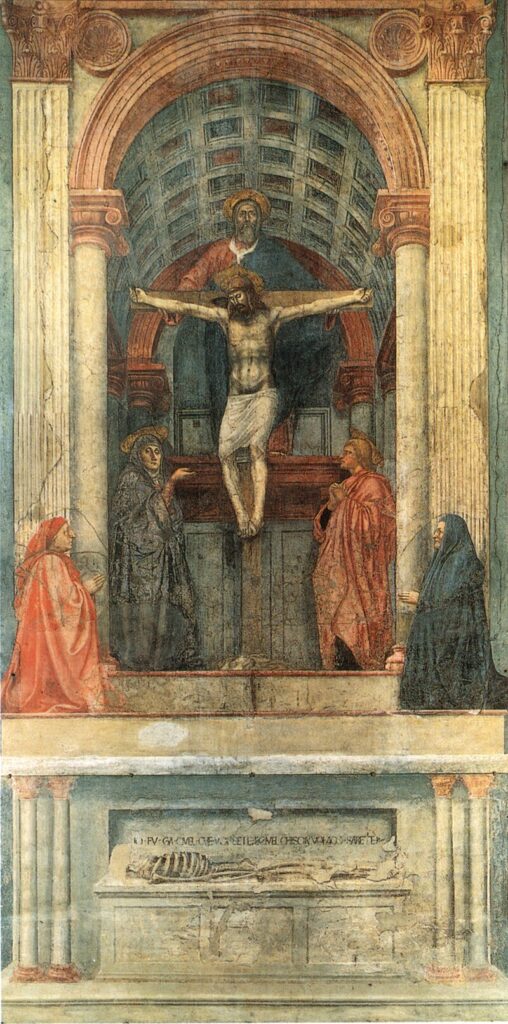
The Holy Trinity by Masaccio is a fresco painting from the Early Renaissance period, completed in 1427. This masterpiece can be found at the Basilica di Santa Maria Novella in Florence, Italy and has been highly admired and studied ever since. The painting depicts three figures – God the Father, Jesus Christ, and the Holy Spirit – placed vertically to form a cohesive image of the Holy Trinity.
Masaccio utilized one-point perspective to create depth and realism within this work of art. The contrast between light and shadow highlights each figure distinctly and brings them to life. The fresco also features inscriptions on the upper portion which emphasize its theme: “I am what you once were; what I am, you will become,” creating both religious symbolism and acknowledging human mortality.
Aside from being a magnificent piece of art that evokes awe in all who see it, The Holy Trinity by Masaccio reflects religious beliefs during his time through expert technique. Its popularity today signifies how art retains its significance over time as both expression of culture or historical artifact for study on various aspects such as religion, philosophy, science etc., making us appreciate further their impact as well as beauty they offer to enrich our lives.
2. The Battle Of San Romano By Paolo Uccello – C. 1435–1460
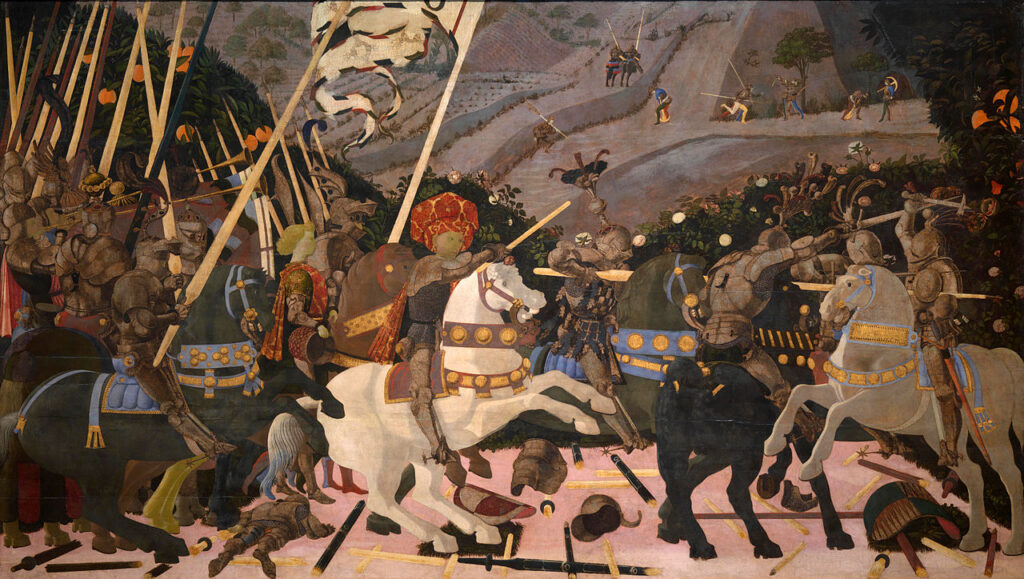
The Battle Of San Romano is a series of three paintings created by Renaissance artist Paolo Uccello between 1435 and 1460. The panels depict events that took place during the Battle of San Romano in 1432, which was fought between Florence and Siena. Uccello depicts not only the violence and brutality of war but also the pageantry associated with it.
In the first panel, we see mounted knights engaging in combat with lances, swords, and shields. The horses themselves are depicted in dramatically angled positions to give a sense of movement and energy to the scene. In the second panel, there is a tangle of fallen riders and horses, creating chaos on the battlefield. In contrast to this violent image is an elaborate display of brightly colored armor worn by soldiers on horseback.
Finally, in the third panel, we see Florentine foot soldiers pushing back against their enemies while archers take aim from behind them. The scene takes on a more organized feel as formations become apparent among both sides’ troops.
3. Flagellation Of Christ By Piero Della Francesca – C. 1468–1470
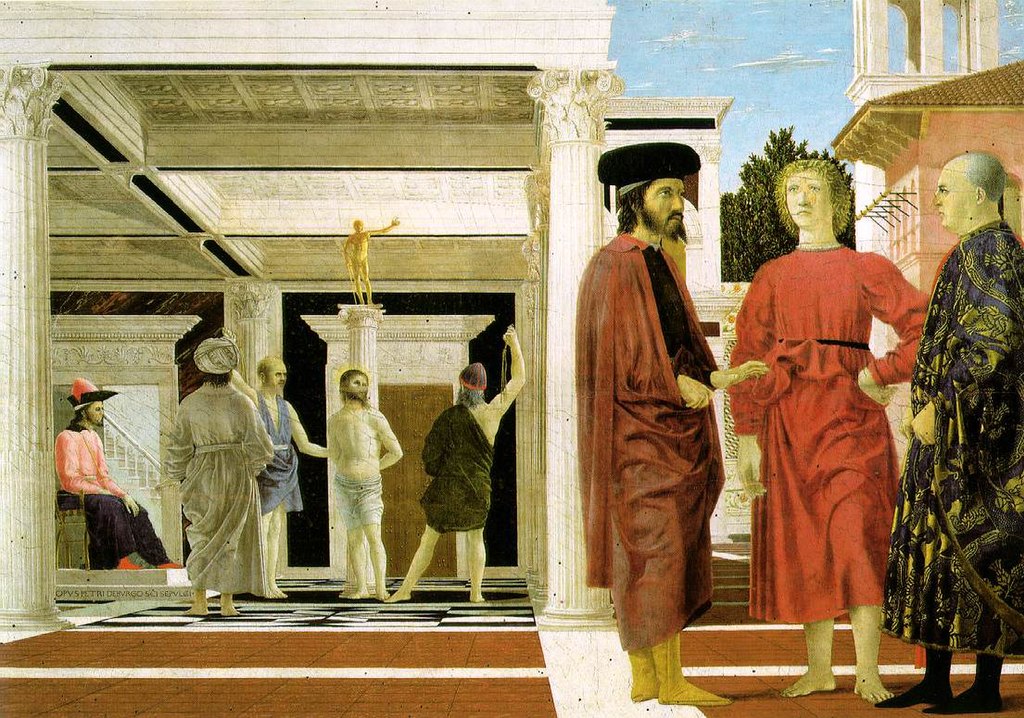
The Flagellation of Christ by Piero Della Francesca is a masterpiece of Renaissance art. Created between 1468 and 1470, the painting depicts the moment when Jesus Christ is being whipped before he was sent to be crucified. This painting is unique because it portrays Christ in a state of serenity and acceptance rather than pain and suffering.
The composition of the painting is well-balanced with its symmetrical design. Piero uses colors such as blue, white, red, and brown to create a calming effect on the viewer’s eyes. The figures blend beautifully with their surroundings creating more depth in this piece. As we look at the painting closely, we notice that Piero has given attention to details in every aspect within the work.
Moreover, Piero’s use of perspective makes each character seem three-dimensional; this technique showcases his technical skill as an artist of perspective during his time period. In conclusion, The Flagellation Of Christ by Piero Della Francesca is a must-see artwork if you appreciate Renaissance art or would like to have an overall understanding of Christian iconography used throughout Italian history until today.
4. St. Jerome In His Study By Antonello Da Messina – C. 1474
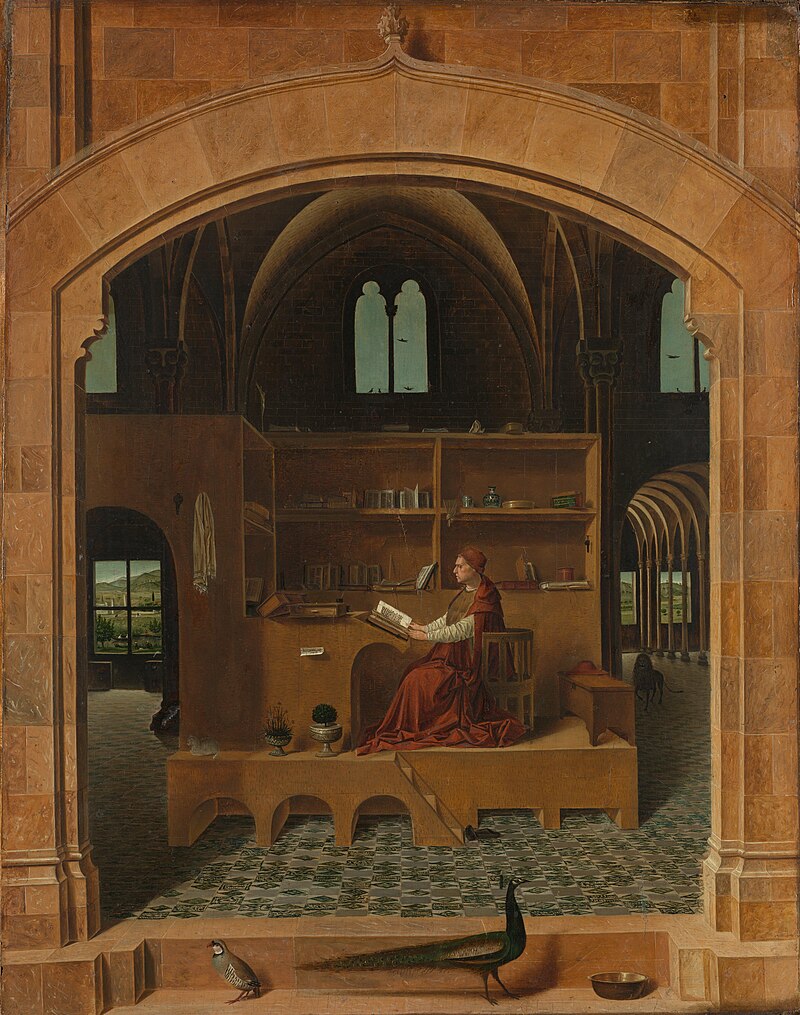
St. Jerome in his Study is a painting created by Antonello Da Messina circa 1474. The painting depicts St. Jerome, who was known as one of the Four Fathers of the Latin Church, sitting in his study with a lion by his side. The painting is notable for its realistic portrayal of textures and details, such as the wood grain on the desk and bookshelf or the wrinkles on St. Jerome’s face.
The painting is also significant for its use of light and shadow to create depth and dimension in the image. Antonello Da Messina used an oil-based technique called sfumato to achieve this effect, which involves layering thin washes of paint to produce soft transitions between light and dark areas.
In addition to its aesthetic qualities, St. Jerome in his Study has been interpreted as a symbol of Christian humanism, which emphasized the importance of knowledge, reason, and classical learning within a Christian framework. This interpretation is supported by St. Jerome’s position as a renowned scholar who translated the Bible into Latin and contributed greatly to theological debates during his lifetime.
5. Lamentation Of Christ By Andrea Mantegna – C. 1480
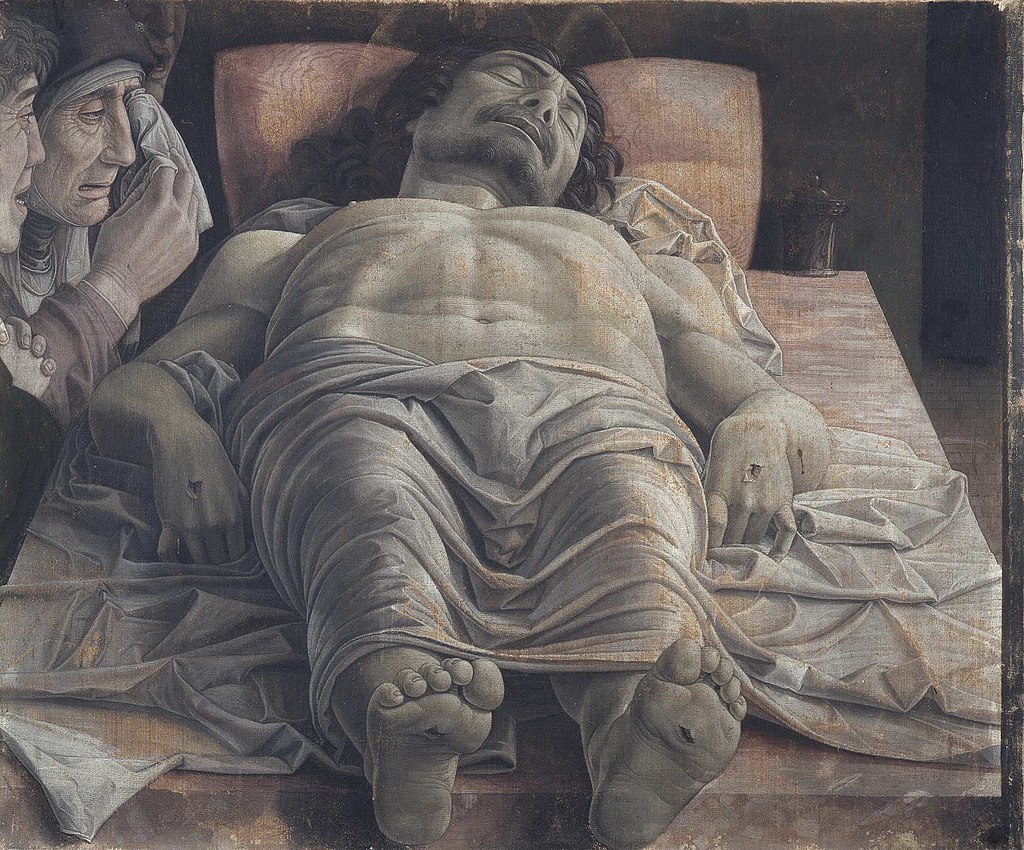
Lamentation Of Christ by Andrea Mantegna is a painting from the late 15th century that depicts the mourning of Jesus Christ after his crucifixion. A life-size depiction, it is considered one of Mantegna’s most famous works due to its innovative use of foreshortening and trompe-l’œil techniques.
Foreshortening is a method used by artists to create the illusion of depth and perspective in a two-dimensional space. In Lamentation Of Christ, Mantegna uses foreshortening to place the viewer within the scene, as if they were standing alongside Mary and St. John as they mourned over Christ’s body. This technique was revolutionary for its time and made a significant impact on Italian Renaissance art.
Trompe-l’œil, or “trick of the eye” in French, refers to an artistic technique that creates an optical illusion where three-dimensional objects appear to be within reach. This technique was used specifically in Lamentation Of Christ by Mantegna when he created cracks on a stone slab that gives viewers an impression that it is coming off like ti was like real fourbes stone bu chipping rather than paint giving a greater realism creating another layering skills he employed.
6. Delivery Of The Keys By Pietro Perugino – C. 1481–1482
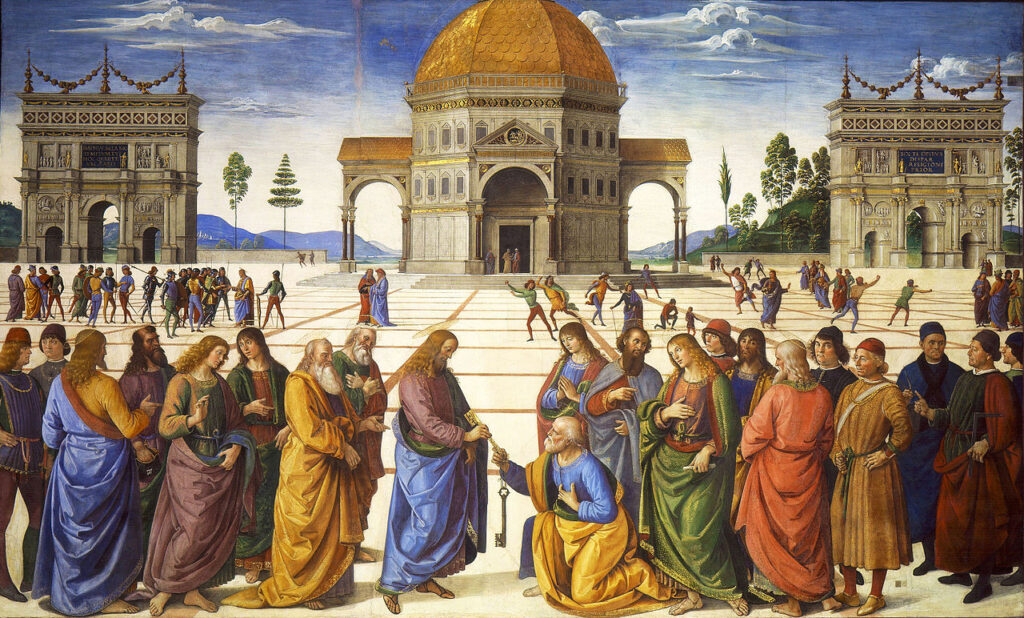
Pietro Perugino’s Delivery of the Keys is an iconic artwork that portrays Jesus Christ delivering the keys to heaven to Saint Peter. Completed between 1481-1482, it is a celebrated masterpiece from the high Renaissance period. This significant moment in Christian tradition came to represent the establishment of the papacy and gave authority to Saint Peter as the first pope.
Aside from its historical importance, Perugino’s work shows exceptional skill in execution. The painting is located on the ceiling of the Sistine Chapel in Vatican City and measures roughly 11 feet by 18 feet. It portrays a simplistic yet powerful message achieved through expert use of color and perspective. Jesus stands at the center of attention surrounded by his disciples, while Saint Peter kneels before him with his hands extended towards receiving his holy duty.
The beauty and symbolism present in Delivery Of The Keys by Pietro Perugino has made it famous around the world, inspiring awe in all those who witness it. The painting’s permanence on display at Vatican City allows art enthusiasts throughout time to admire one of history’s most notable Renaissance works of art.
7. Primavera By Sandro Botticelli – C. 1477–82
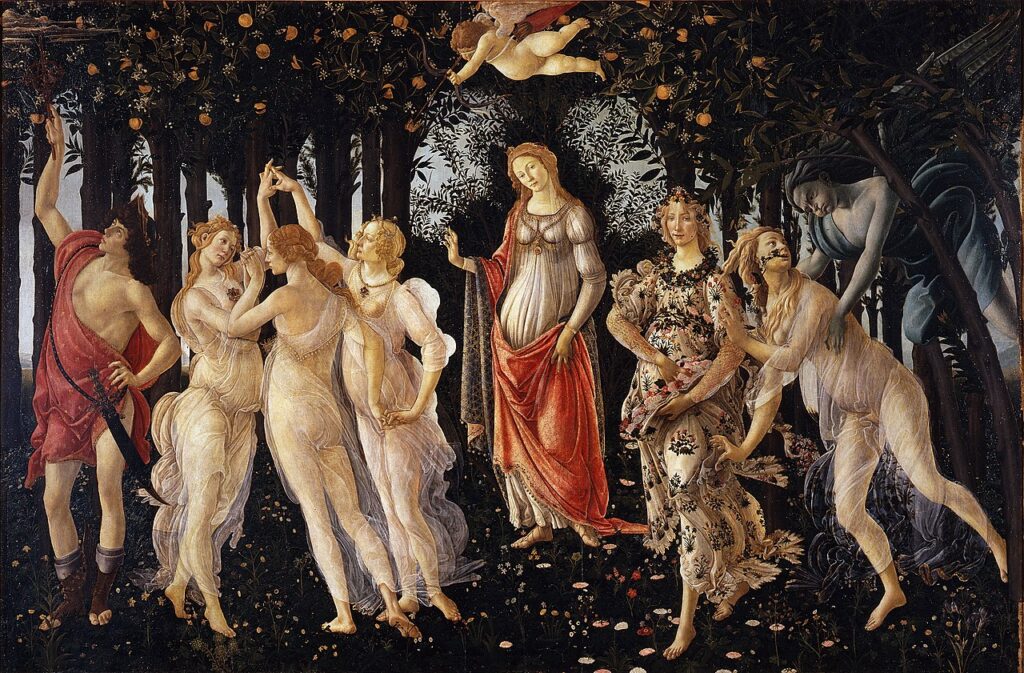
Primavera is one of Sandro Botticelli’s most famous paintings, created between 1477 and 1482. It measures 6 feet by 10 feet and can be found at the Uffizi Gallery in Florence. The painting depicts a group of mythological figures in a garden, with Venus standing at the center.
Botticelli employed both literary sources and religious symbolism to create this masterpiece. The figures in the painting are all related to springtime and love in different ways. Venus represents love, while Cupid shoots his arrow of desire towards her. Flora, Chloris, and Zephyrus are all symbols of springtime fertility.
The painting is highly detailed, with intricate patterns on the clothing of each figure, emphasizing their individuality while also creating unity as a group. The background is lush with vegetation consisting mostly of orange trees that symbolize fertility and rebirth.
It’s important to note that Primavera was created during the Renaissance period, which valued balance, harmony, and perspective. These elements are evident through Botticelli’s use of symmetry throughout the painting.
8. Virgin Of The Rocks By Leonardo Da Vinci – 1483–1486
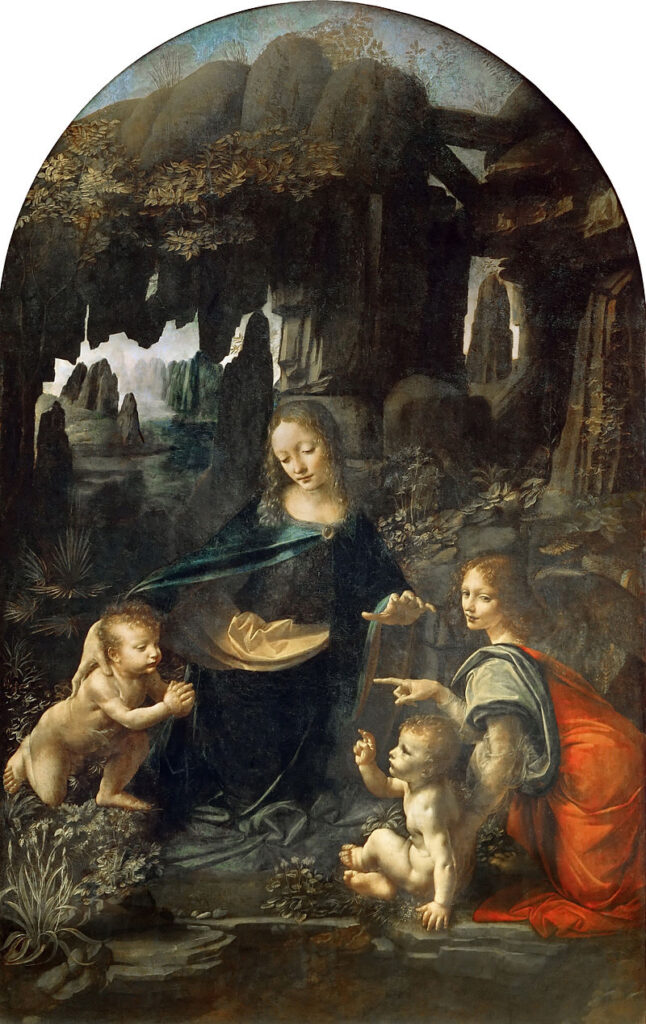
The Virgin of the Rocks is a painting by Leonardo da Vinci created between 1483-1486. It depicts the Virgin Mary, baby Jesus, an angel, and John the Baptist in a rocky grotto illuminated by light from an unknown source. This painting was commissioned as an altarpiece for the Confraternity of the Immaculate Conception in Milan.
One notable aspect of this painting is its depth and use of chiaroscuro to create realistic shadows and highlights. The figures appear almost sculptural due to their lifelike textures and sense of three-dimensionality. Da Vinci’s usage of sfumato technique or blending colors together subtly adds to this effect.
There are two versions of this painting, both considered masterpieces. One can be found in Paris’ Louvre Museum while The National Gallery in London houses another version that displays notable differences such as the inclusion of palms leading towards Jesus instead of rocks pointing outwards from Him. Despite these differences, both versions provide insight into Da Vinci’s mastery of creating atmospheric effects through brushwork and lighting techniques that continue to astound art enthusiasts worldwide.
9. Birth Of Venus By Sandro Botticelli – C. 1484–1486
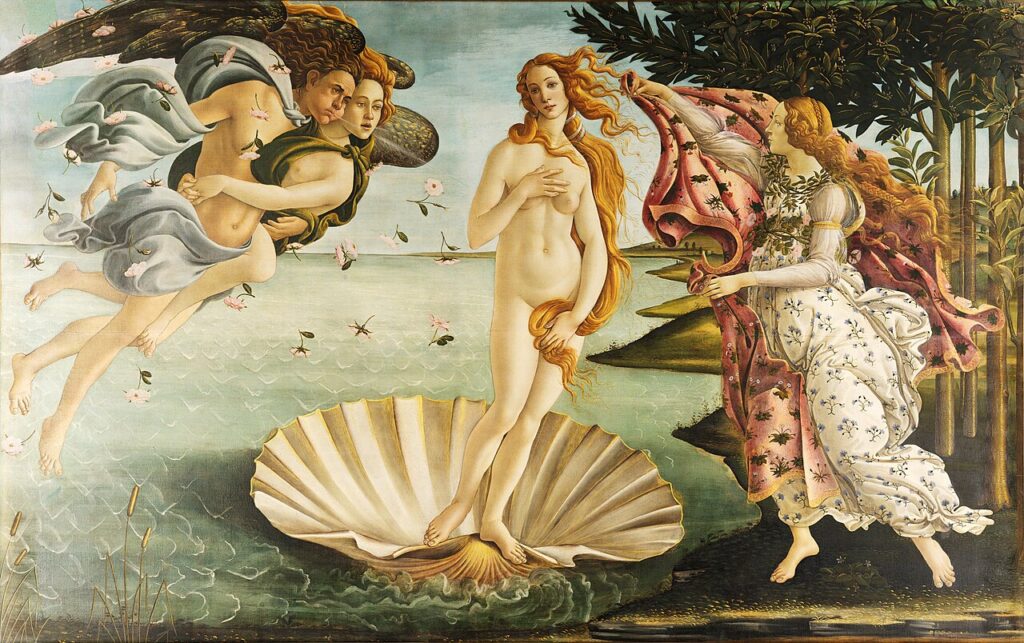
Birth of Venus by Sandro Botticelli is a painting created between 1484 and 1486. It depicts the Roman goddess Venus as she emerges from the sea, standing on a shell as it is pushed to shore by two figures, one on each side. The painting is believed to have been commissioned by the Medici family.
The painting is known for its intricate details and beautiful use of color. Botticelli made use of pastel colors in creating the painting, which gives it a soft, dream-like quality. The clothing of the figures in the painting is also notable, as they are depicted wearing flowing robes that appear to move with the wind.
One interpretation of the painting is that it represents the idea of divine love and beauty. The figure of Venus represents worldly beauty and love, while her birth from sea foam symbolizes spiritual rebirth. Another interpretation suggests that Birth of Venus was created as an allegory for Florence’s transformation into a Republic after being ruled by authoritarian powers.
10. Lady With An Ermine By Leonardo Da Vinci – C. 1489–1491
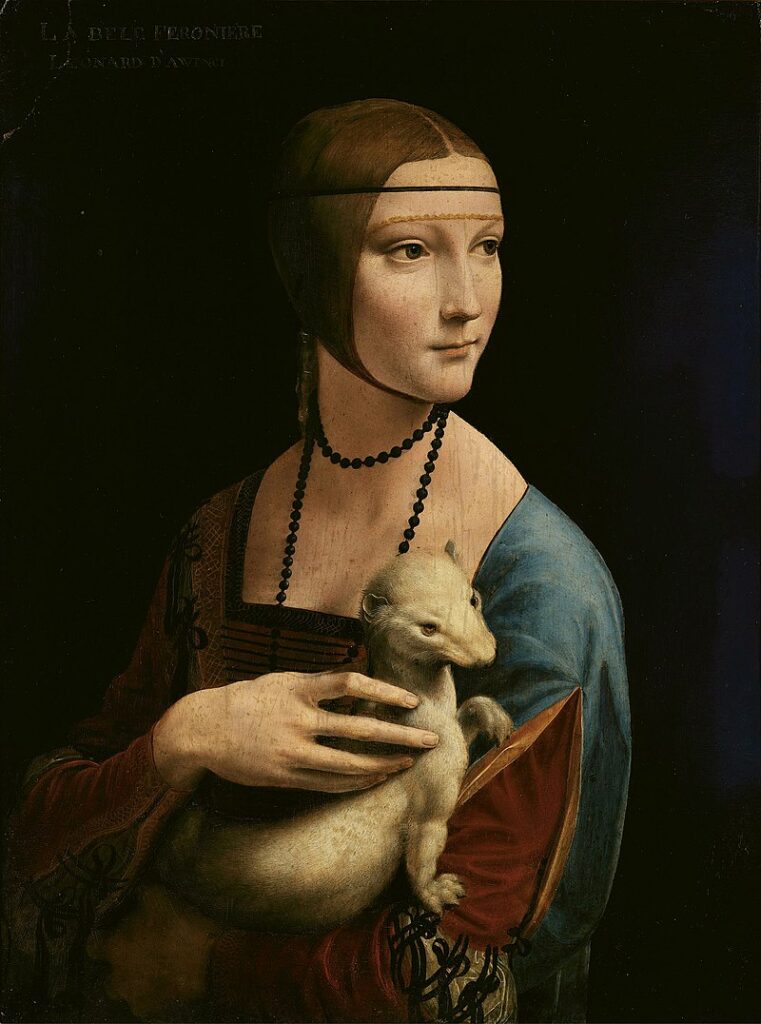
The Lady With An Ermine is a painting created by the famous artist Leonardo Da Vinci between 1489-1491. It portrays Cecilia Gallerani, who was a mistress of Ludovico Sforza, Duke of Milan. In the painting, Cecilia is holding an ermine which is said to symbolize her purity and fidelity.
This masterpiece utilizes Da Vinci’s signature sfumato technique which creates a soft blending effect that adds depth to the painting. The details of the ermine’s fur and Cecilia’s hair are beautifully rendered through this technique.
Currently housed at Czartoryski Museum in Krakow, Poland, many art enthusiasts from around the world visit this museum to view this masterpiece up close and personal. This painting is not only valuable for its historical significance but also for its impeccable artistry that continues to fascinate people even today.
11. The Last Supper By Leonardo Da Vinci – 1495–1498
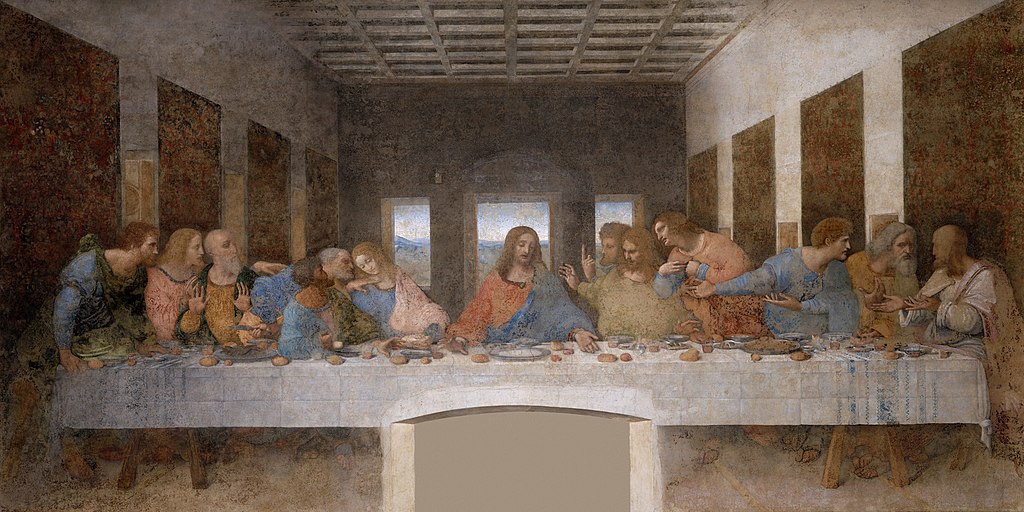
Leonardo Da Vinci’s The Last Supper has been one of the most admired and studied paintings in history. Painted between 1495-1498, it depicts Jesus with his twelve apostles during their last meal before his crucifixion. The painting is located in the refectory of the Santa Maria delle Grazie church in Milan, Italy.
The painting measures 15 feet by 29 feet and covers an entire wall. It was painted using a technique called tempera and oil on plaster. The use of this technique meant that the painting began to deteriorate within years of its completion.
Da Vinci’s exceptional attention to detail can be seen throughout the painting. Each apostle has a different expression, which conveys their reaction to Jesus’ announcement that one will betray him. Judas Iscariot, who betrayed Jesus, is shown with dark hair and a beard, while all other apostles have light-colored hair and beards.
The composition itself is remarkable as it captures movement while still appearing static due to strong symmetrical balance within the image. Da Vinci used linear perspective techniques to create depth and convey spatial relationships between figures which gave an illusion that there was more space beyond what was on the picture plane.
12. The Marriage Of The Virgin By Raphael – 1504
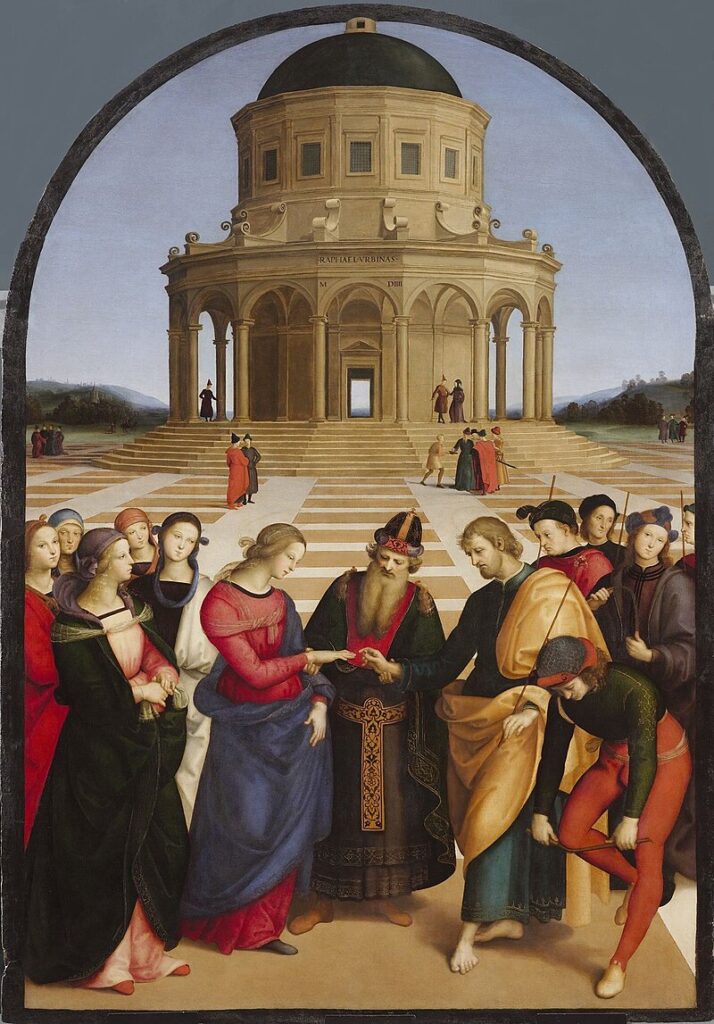
Raphael’s Marriage of the Virgin is an oil painting created in 1504. The artwork depicts the marriage ceremony of Mary and Joseph, with a group of onlookers that includes priests and family members. The painting has a warm color scheme with hues of red, brown and orange.
The composition is well-balanced with elegant lines that draw attention to the central figures. Mary is depicted as demure while Joseph appears more stern, as if lost in thought. Raphael’s attention to detail can be seen in the intricately designed Byzantine-style architecture in the background which adds depth to the painting.
The piece is considered a masterpiece due to its intricate details and serene tone, typical characteristics of Renaissance art. This work has been admired for centuries for its beauty and religious significance, making it one of Raphael’s most famous works.
It’s important to note that this painting was commissioned by the Albizzini family for their chapel in San Francesco al Prato church located outside Perugia Italy, where it remained until it was moved to France as war booty during Napoleon’s Italian campaign period from 1796-1800 before returning back to Italy after his reign ended.
13. Doni Tondo By Michelangelo – 1506
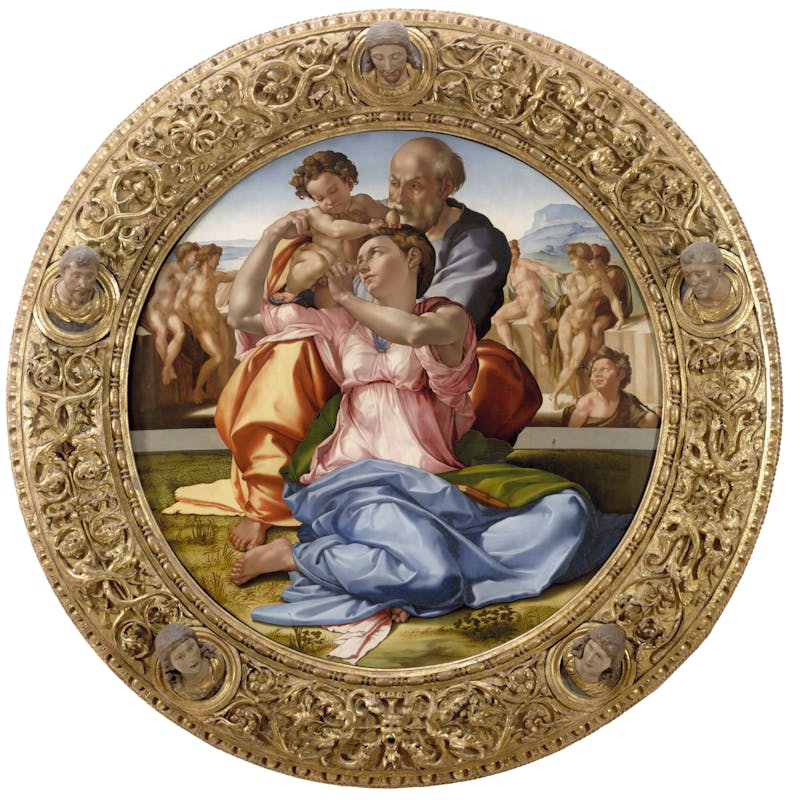
Doni Tondo is a painting by Michelangelo, created in 1506. The painting depicts the Holy Family – Jesus, Mary and Joseph – in a circular composition. The figures are depicted in three dimensions, with careful attention paid to their musculature and anatomy.
The painting’s composition is complex and dynamic. Mary is seated on a rock, holding the baby Jesus on her lap, while Joseph stands behind them. The figures seem to be intertwined in an almost sculptural way, creating a sense of movement and energy.
Michelangelo’s use of color and light in Doni Tondo is also notable. The background of the painting is a deep blue-green color, which creates a sense of depth and atmosphere. The figures themselves are portrayed using vivid colors that pop against this dark background.
14. The Mona Lisa By Leonardo Da Vinci – 1506
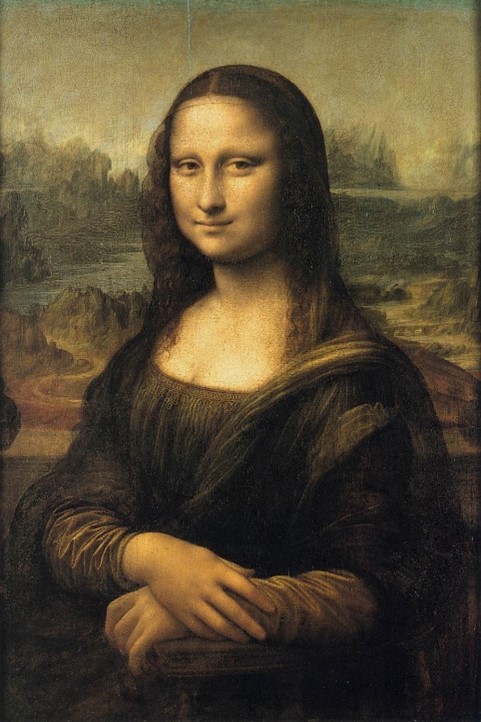
https://collections.louvre.fr/en/ark:/53355/cl010062370
The Mona Lisa is a 16th-century portrait painting by the renowned artist Leonardo da Vinci. It depicts a woman with an enigmatic smile, who is believed to be Lisa Gherardini, the wife of a Florentine merchant. The painting was completed in 1506 and has since become one of the most famous and iconic paintings in history.
One of the most striking aspects of the painting is its use of sfumato, a technique that involves blending colors and tones together to create a soft and hazy effect. This technique gives the painting a dreamlike quality and adds to its overall sense of mystery.
The subject’s pose has also been widely studied and analyzed by art historians and scholars. Her posture appears relaxed yet controlled, with her shoulders angled slightly towards us while her head leans slightly away. This creates an illusion of depth and contributes to the feeling that she is almost animated.
Despite being over 500 years old, The Mona Lisa remains as fascinating today as it was when it was first painted. Its timeless beauty, intricate details, subtle color palette, mysterious subject matter continue to captivate audiences around the world.
15. The Tempest By Giorgione – C. 1506–1508
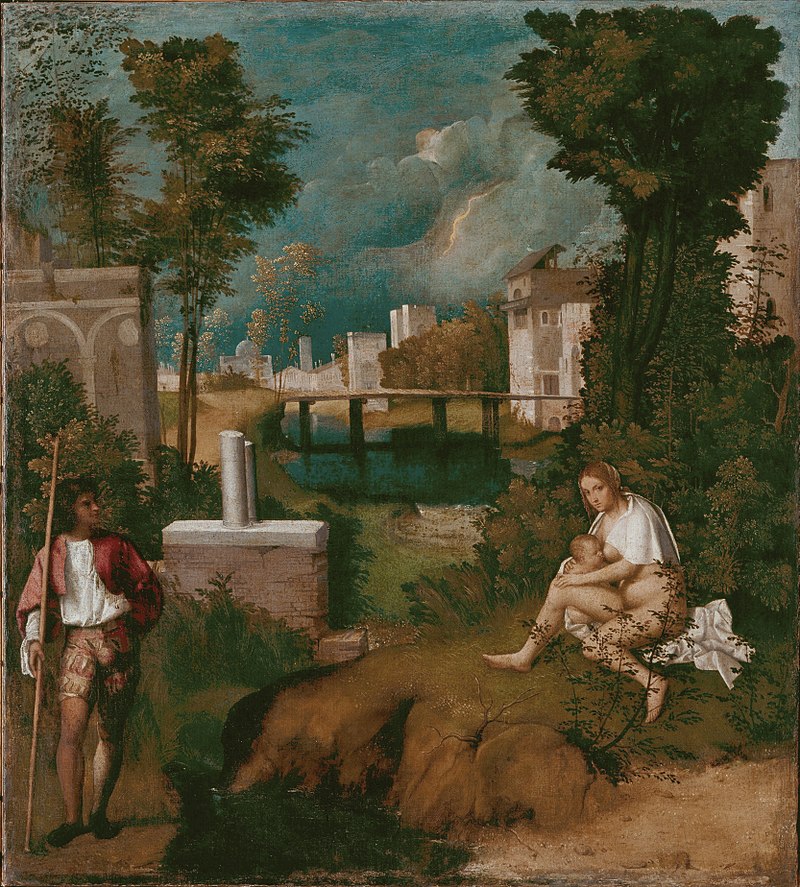
The Tempest by Giorgione is a Renaissance painting done between 1506-1508. The oil painting, measuring 82 cm × 73 cm, portrays an emotional scene of a storm brewing above a seascape. The most striking feature of the piece is undoubtedly the powerful and turbulent sky above, which seems to dominate the whole composition. Tones of brown, green, blue and pink paint are used in thick brushstrokes to create texture in the clouds which billow dramatically.
In the foreground center is an eerie tree twisted by winds while on its left are two people who appear untroubled by what could be violent climatic conditions happening around them. A mother sitting down suckling her baby and beside her stands a young man wearing dishevelled clothing holding either a staff or spear (some suggest as connotation to Saint Joseph), looking directly at viewers – challenging interpretation as his expression is somewhat ambiguous.
Giorgione’s The Tempest remains enigmatic with its exact meaning debated for centuries since it was created. The lack of concrete symbols means that there may not be one final interpretation but rather open dialogues through time about what it represents scientifically or otherwise in line with art movement from one generation to another.
16. The School Of Athens By Raphael – 1509–1511
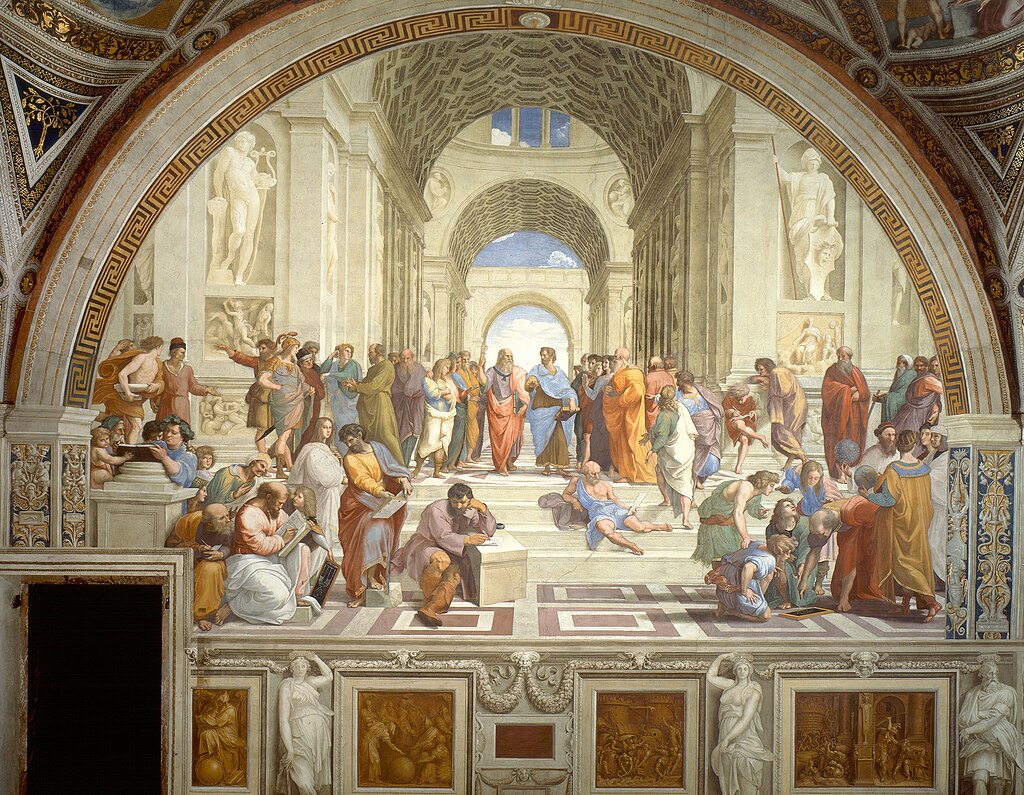
The School of Athens is a fresco painting by Italian Renaissance artist Raphael, which was painted between 1509 and 1511. It is located in the Vatican Palace, specifically in the Stanza della Segnatura. The painting depicts various philosophers from Ancient Greece gathered together as if they were at a school.
The two main figures in the painting are Plato and Aristotle, both of whom are at the center of the composition. Plato is shown pointing upward to signify his belief that knowledge must come from above, while Aristotle points outward to symbolize his belief that knowledge can be obtained from observation and experience. Other notable figures depicted include Socrates, Euclid, Pythagoras, and Archimedes.
One interesting aspect of The School of Athens is how Raphael incorporated contemporary figures into the painting. For example, he included a figure whose likeness resembles Michelangelo, who was working on the ceiling frescoes of the same room at that time. Raphael also included himself in the painting as one of the bystanders looking on.
17. Creation Of Adam By Michelangelo – C. 1508–1512
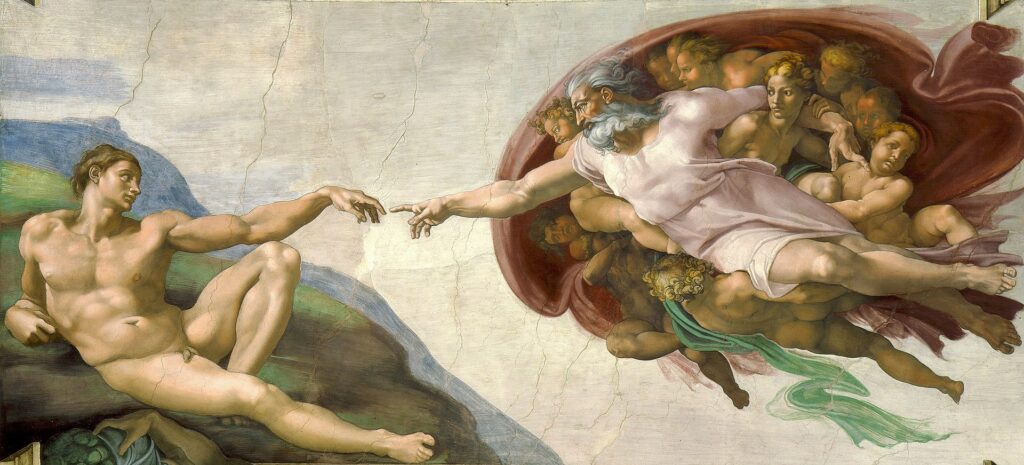
Michelangelo’s Creation of Adam is a painting located on the ceiling of the Sistine Chapel in Vatican City. It was created between 1508 and 1512 as part of a larger series of frescoes commissioned by Pope Julius II. The painting depicts the moment when God gives life to Adam, who is lying naked on the ground.
The composition shows God floating amongst clouds, with his arm outstretched towards Adam. Their fingers are not touching but are almost touching each other. This Michelangelo intended to represent God giving life to Adam.
The painting has been widely interpreted as an allegory for the creation story in the Bible’s Book of Genesis – specifically, that moment when God breathed life into man and brought him into existence. The magnificent details and sublimity in this masterpiece make it an icon in Western art history that emphasizes Florence’s Renaissance movement in Italy during this period.
18. Sacred And Profane Love By Titian – 1514
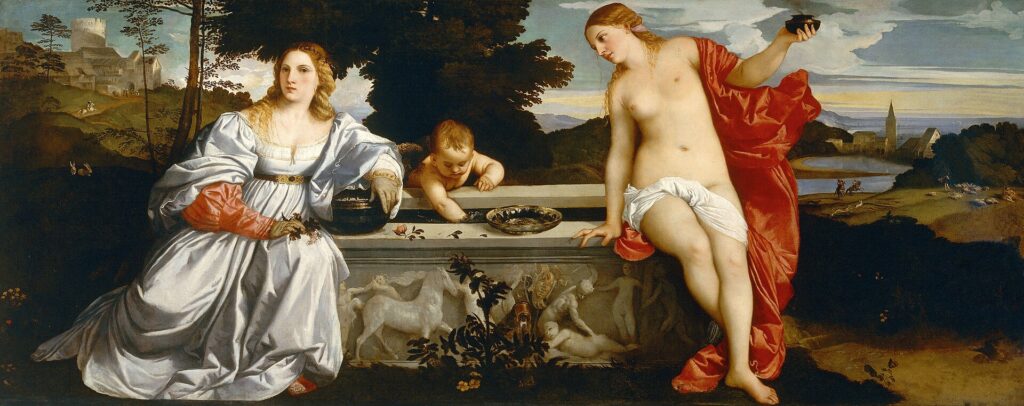
Titian’s Sacred And Profane Love is a painting that has sparked controversy for years, with scholars and art enthusiasts debating whether it truly depicts sacred or profane love. The painting features two women, one dressed in white to symbolize sacred love and the other in dark clothing to represent profane love. Both women are holding a vase, which could either represent the combination of both sacred and profane elements or highlight the juxtaposition between them.
The artwork was crafted in 1514 during Titian’s early career as one of the most talented painters of the Renaissance period. Despite being almost 500 years old today, it remains a masterpiece due to its unique interpretation by viewers who piece together Titian’s intended message from its complex composition.
Various interpretations exist, but academic discourse continues on what exactly that message is primarily because the different perspectives present are all plausible. Some argue that Titian is signaling that all love is indeed trivialized through ostentatiously lavish surroundings—that even our holiest experiences need space away from casual luxuries present everywhere else for true joy; others may believe he was expressing his thoughts about how sex (profane) was intertwined with divine consecration (sacred).
19. Venus Of Urbino By Titian – 1538
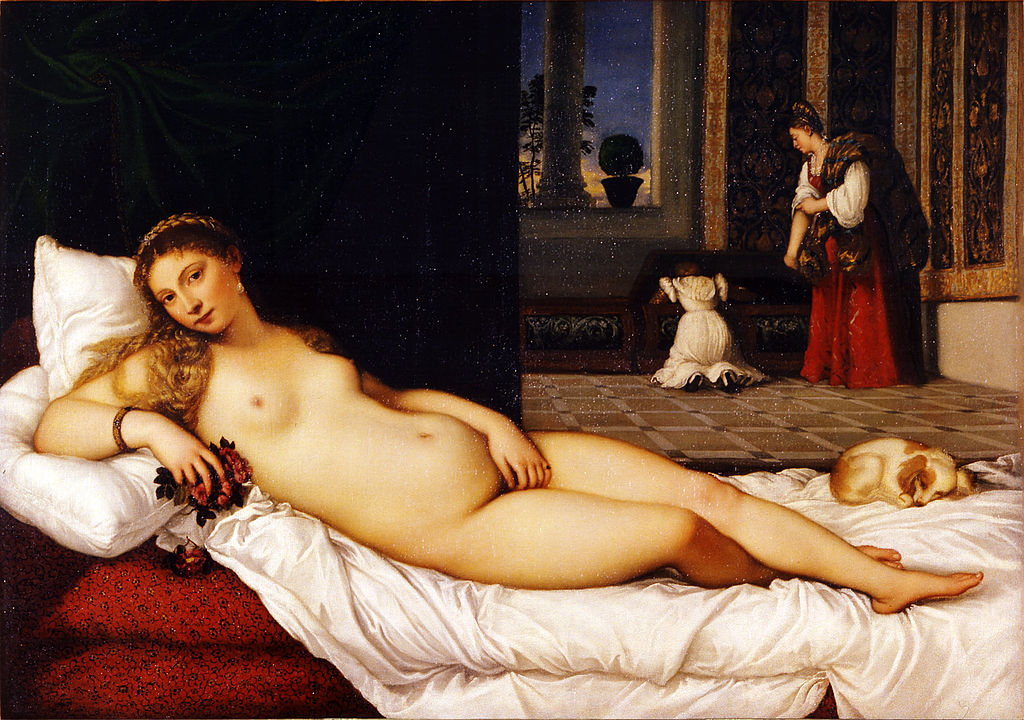
Venus of Urbino is a painting by Italian artist Titian, completed in 1538. The painting depicts a reclining nude woman, identified as the Roman goddess Venus, on a bed in an indoor setting. She is portrayed in the idealized form of beauty popular during the Renaissance period.
Titian painted Venus of Urbino for Guidobaldo II della Rovere, the Duke of Urbino. The painting was intended as a gift to his newlywed wife, who can be seen in the background attending to her toilette. The painting has been interpreted as both an erotic and domestic work of art.
The composition of Venus of Urbino is influenced by Giorgione’s Sleeping Venus but Titian adds his own interpretation to it. He uses vivid colors with striking contrast between warm and cool tones and achieves realism through techniques like sfumato (blurring edges), which creates depth and makes figures look more lifelike. These techniques were characteristic of Titian’s style and contributed to him being considered one of the most important painters during the Renaissance period.
20. The Last Judgement By Michelangelo – 1541
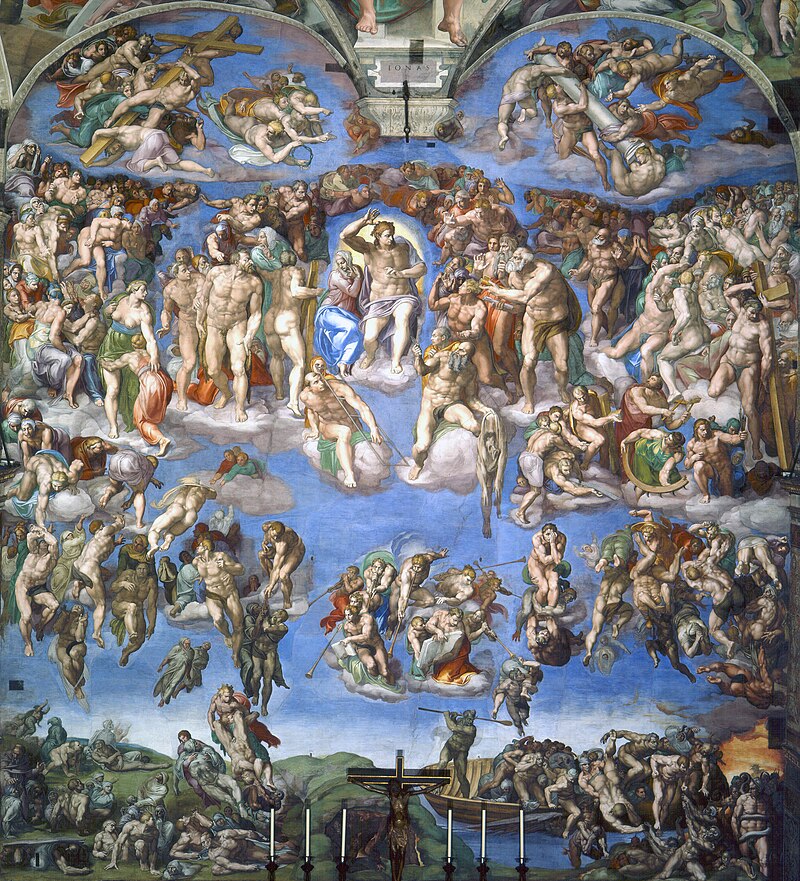
“The Last Judgement” is a mural painted by Michelangelo and located in the Sistine Chapel. It was completed in 1541 and covers the entire altar wall of the chapel. The painting depicts the second coming of Christ, where he judges souls before granting them entry into heaven or consigning them to hell.
At over 40 feet tall, “The Last Judgement” is a massive work of art that took Michelangelo four years to complete. More than 300 figures are depicted in various states of ascent or descent to their final destination. Notably, the painting depicts many muscular nudes, which was controversial at its unveiling during the Counter-Reformation.
One important aspect of “The Last Judgement” is how Michelangelo portrayed himself in it. He included his own self-portrait as St. Bartholomew’s skin held by St. Bartholomew himself, with his face appearing flayed on this skin – perhaps a reference to other artists’ criticism who were unhappy with his previous works.
21. Miracle Of St. Mark by Tintoretto
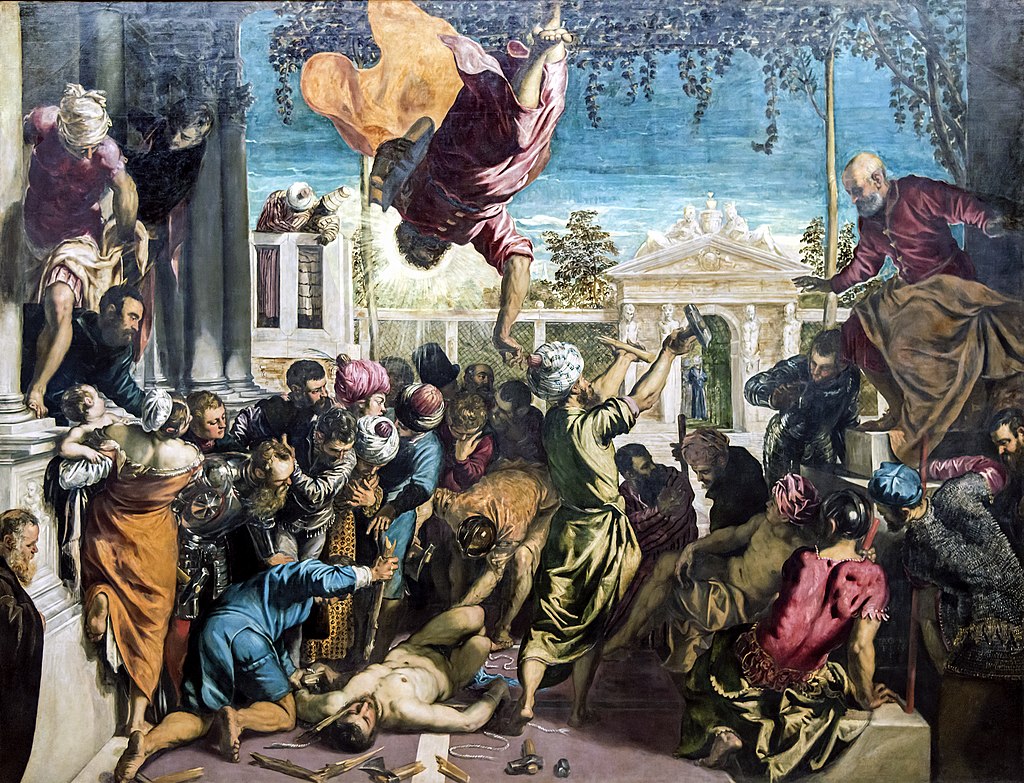
Tintoretto’s painting, “The Miracle of St. Mark,” depicts a scene from the life of St. Mark in which he rescues a slave from a tyrant. The dramatic lighting and dynamic composition create an intense atmosphere that emphasizes the urgency of the situation. This masterpiece is considered one of Tintoretto’s most impressive works.
In “The Miracle of St. Mark,” Tintoretto captures the moment when St. Mark intervenes to save a slave from being tortured by a cruel ruler. Tintoretto’s skillful use of light highlights the contrasting emotions on each figure’s face, drawing attention to their expressions and gestures. The painting’s dynamic composition creates a feeling of movement and energy that intensifies the sense of urgency in the scene.
Tintoretto was known for his ability to infuse his paintings with drama, depth, and intensity, and “The Miracle of St. Mark” is no exception. His use of striking colors and bold brushstrokes adds to the overall impact, making this painting an unforgettable work of art.
22. Resurrection Of Christ by Piero Della Francesca
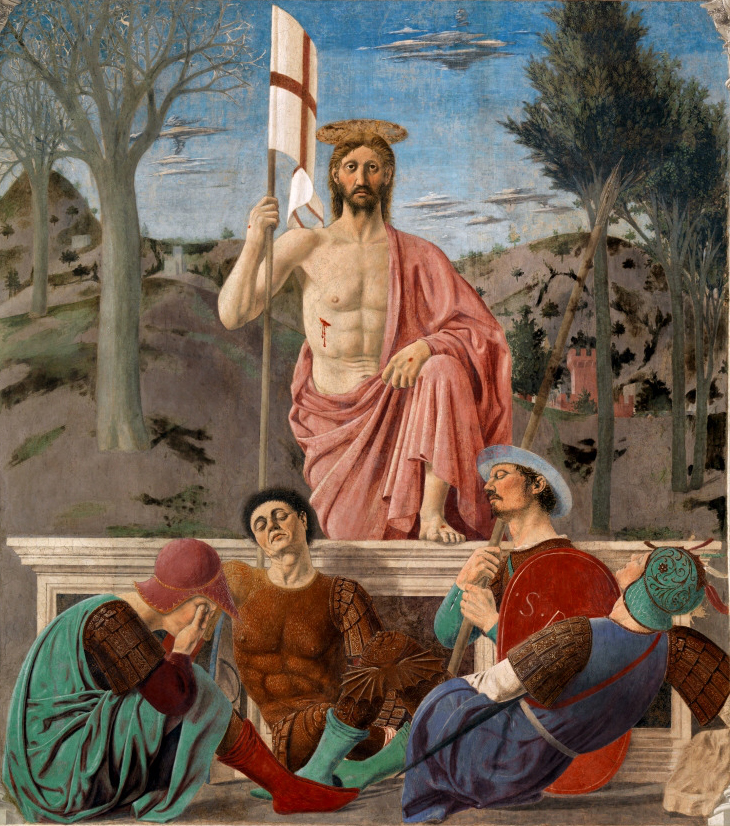
Piero della Francesca’s Resurrection of Christ is a painting that depicts Jesus emerging from his tomb after his crucifixion. The painting is believed to have been created in the 1460s and is now housed at the Museo Civico in Sansepolcro, Italy.
The painting features a mix of elements from both Byzantine and Western styles, with an emphasis on mathematical precision and perspective. Jesus stands tall in the center of the painting, with his arms held out towards heaven. The figures surrounding him are depicted with great detail, each one showing a different expression of awe and amazement at what they are witnessing.
One unique aspect of this painting is its use of light and shadow to create depth and dimensionality. The figure of Christ appears to glow with an otherworldly radiance, while the stone walls surrounding him cast deep shadows that heighten the drama of the scene.
23. Madonna With Canon Van Der Paele by Jan Van Eyck
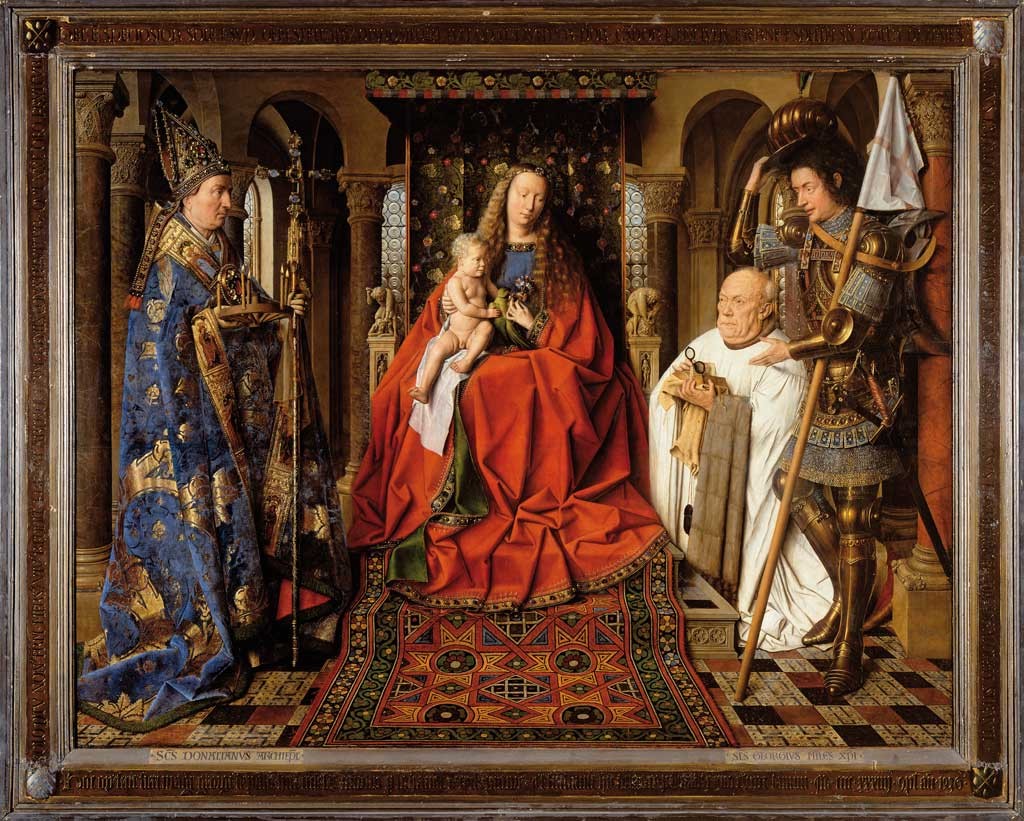
Jan van Eyck’s Madonna with Canon van der Paele is a famous painting depicting the Virgin Mary and Infant Jesus with Canon Joris van der Paele. The painting is considered one of the masterpieces of Early Netherlandish art due to its highly detailed and lifelike portrayal of the subjects.
The painting can be found in the Groeningemuseum in Bruges, Belgium. It was completed around 1436 and is oil on wood panel. The painting measures 141 cm x 176.5 cm, making it a significant work.
Van Eyck paid close attention to every detail, from the texture of fabric to strands of hair, resulting in stunning realism. He also made use of symbolism within his work, including lilies as a symbol for purity and roses for love. Additionally, canon van der Paele’s pose resembles that of Saint Jerome, signaling his importance as an educated man.
24. Henry VIII by Hans Holbein the Younger
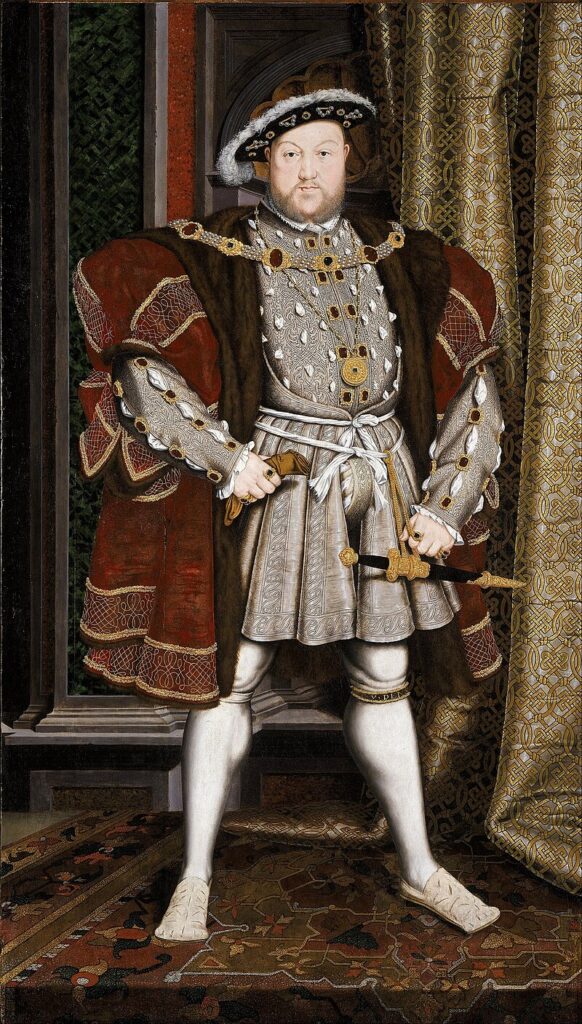
Holbein’s portrait of Henry VIII is a significant artwork that acts as a symbol of power and wealth. Commissioned by the king himself, it captures his physical features and regal demeanor. The portrait highlights the opulent lifestyle led by the monarch, with luxurious fabrics and jewelry adorning him.
Henry VIII’s reign was marked by political and religious upheaval, but this portrait shows no sign of such turmoil. Instead, he is depicted in full royal splendor, exuding confidence and authority. Holbein was a court painter for Henry VIII, and his work on this painting showcases his exceptional talent.
Beyond its artistic merit, this painting also offers insight into one of England’s most renowned monarchs. It serves as a visual record of Henry’s appearance at the time he sat for the portrait. His regalia reveals much about his personality and reign while drawing attention to the politics surrounding royalty during that time.
25. Anne Of Cleves by Hans Holbein the Younger
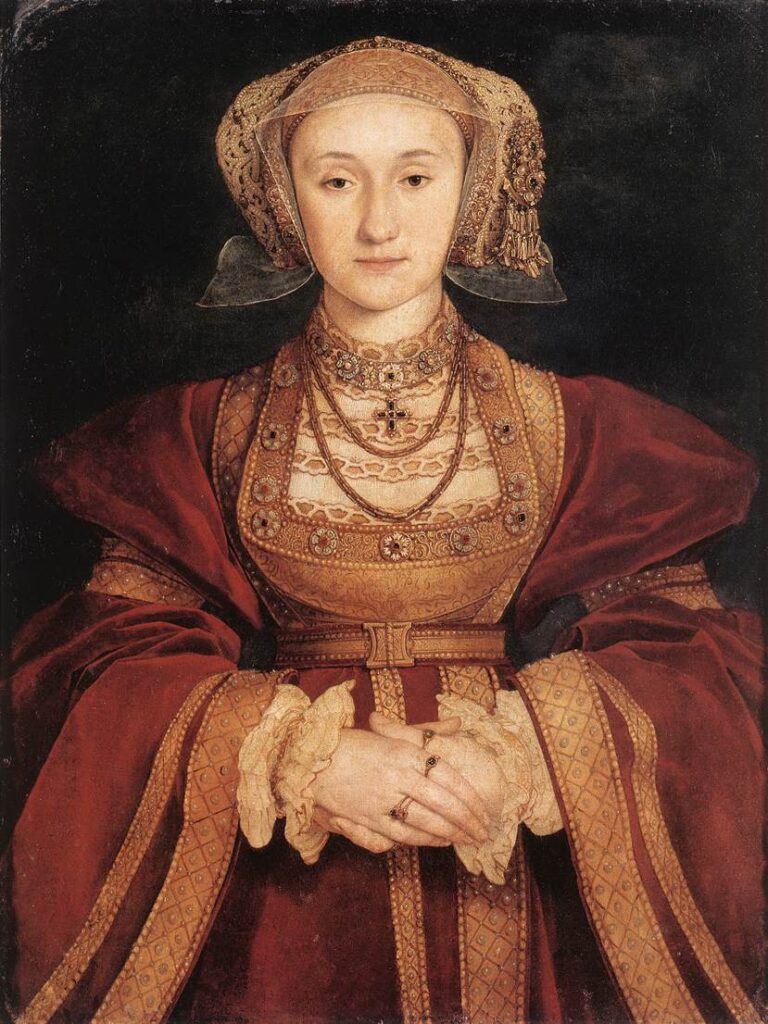
When it comes to the work of German Renaissance artist Hans Holbein the Younger, one painting that often stands out is his portrait of Anne of Cleves. This painting, completed in 1539 when Anne was proposed as a bride to King Henry VIII, is known for its striking realism and detail.
Holbein’s skill in capturing the likeness of his subject is evident in this portrait. Anne is depicted with her characteristic blonde hair and blue eyes, wearing a sumptuous gown adorned with jewels and fur trim. Her expression appears serious but calm.
The background of the painting also holds significance. It features a heraldic device known as the “cleven-leaf rose” which would have been recognizable to anyone familiar with Anne’s homeland of Cleves in Germany. This detail showcases Holbein’s attention to historical accuracy and adds another layer of meaning to the painting.
In examining this piece further, we can see how Holbein’s style combines elements from both Northern European and Italian Renaissance art movements. The precise detail found in the clothing and jewelry are reminiscent of Flemish portraiture, while the use of linear perspective draws upon Italian perspective techniques.
26. The Ambassadors by Hans Holbein The Younger
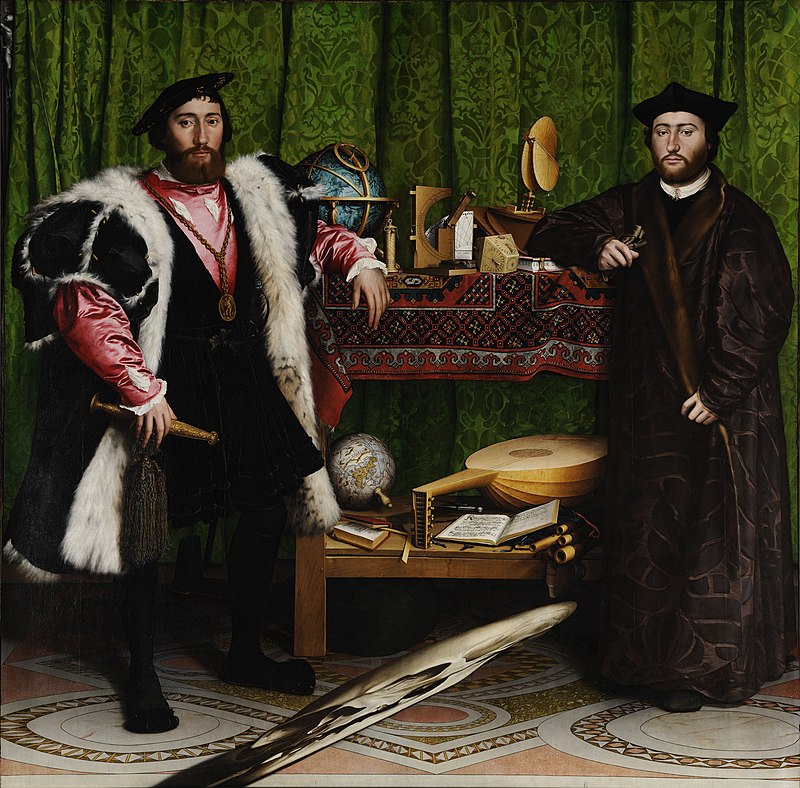
Hans Holbein the Younger’s painting, “The Ambassadors,” is a masterpiece of Renaissance art and a prominent piece in the National Gallery in London. The painting depicts two ambassadors from France standing next to a table filled with objects and symbols related to science, navigation, music, and religion.
One notable aspect of the painting is the distorted skull at the bottom center of the image. Holbein used anamorphic perspective to distort the skull so that it appears normal when viewed from a specific angle. This technique was likely meant to remind viewers of their own mortality and encourage them to reflect on their lives.
The attention to detail in “The Ambassadors” is also noteworthy. The objects on the table are precisely rendered and include instruments such as an armillary sphere and terrestrial globe, as well as musical instruments such as a lute and a hymn book. These items represent education, exploration, and spiritual devotion – all values important to members of society during the Renaissance period.
27. Danae by Titian
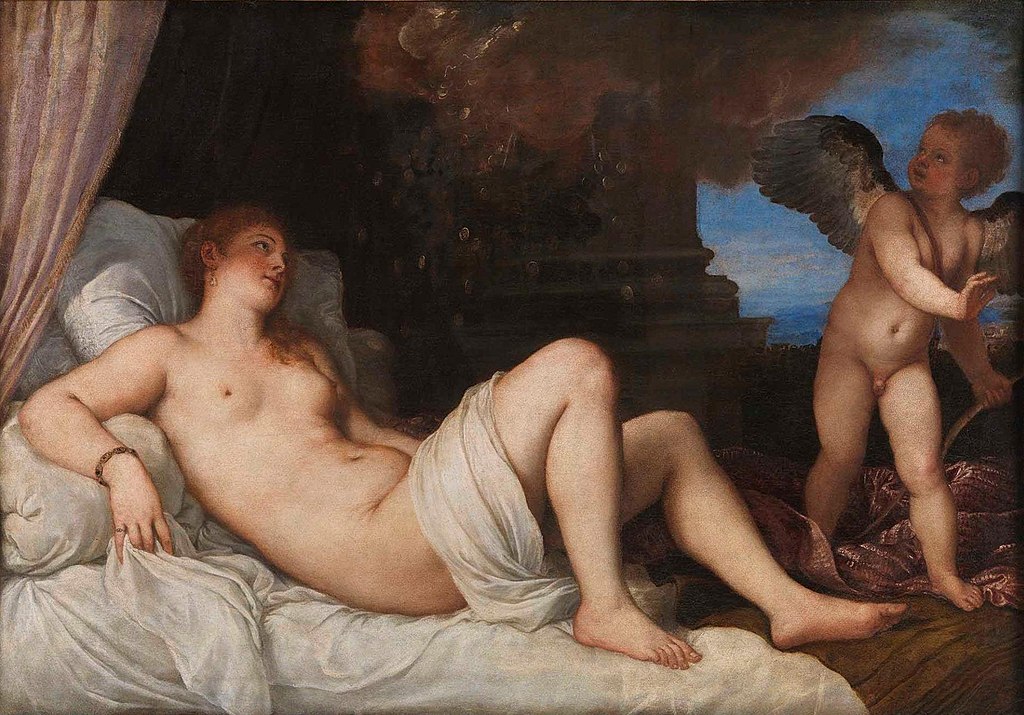
Danae is a painting by the Italian artist Titian, completed in 1545-1546. It depicts the mythological figure Danae lying nude on a bed while being visited by Zeus who is depicted as golden rain falling on her body. The painting measures 120 x 172 cm and is currently housed in the National Museum of Capodimonte, Naples, Italy
Titian painted Danae during his late period when he was exploring complex themes and experimenting with color and light effects. This work exemplifies his skillful use of color contrasts as well as his ability to create depth through chiaroscuro, or the use of contrasting light and dark shades.
The figure of Danae, reclining on a luxurious bedspread, appears relaxed yet captivating. The warm tones used for her skin complement her hair while also standing out against the cool colors used for the background. The depiction of Zeus as golden rain adds an element of sensuality to the painting while also highlighting Titian’s technical proficiency.
28. Venus And Adonis by Titian
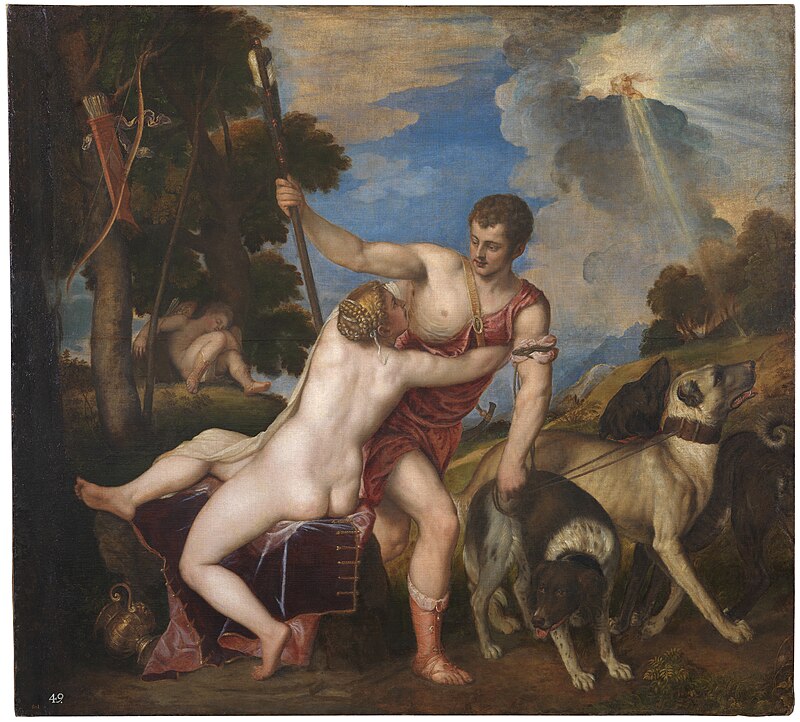
Venus and Adonis is a painting created by Titian, an Italian artist of the Renaissance period. The painting depicts the story of Venus, the goddess of love, and Adonis, her mortal lover. In the painting, Venus can be seen clinging to Adonis as he prepares to leave for a hunting trip. She is depicted in beautiful drapery that flows around her curves while Adonis wears hunting clothes.
One of the prominent features of this painting is its use of color. Titian used bold colors such as reds and greens to highlight different elements in the painting. This gave Venus’ drapery and Adonis’ clothing texture that made them appear more realistic. Additionally, Titian’s use of light creates depth in his art piece.
29. Baldassare Castiglione by Raphael
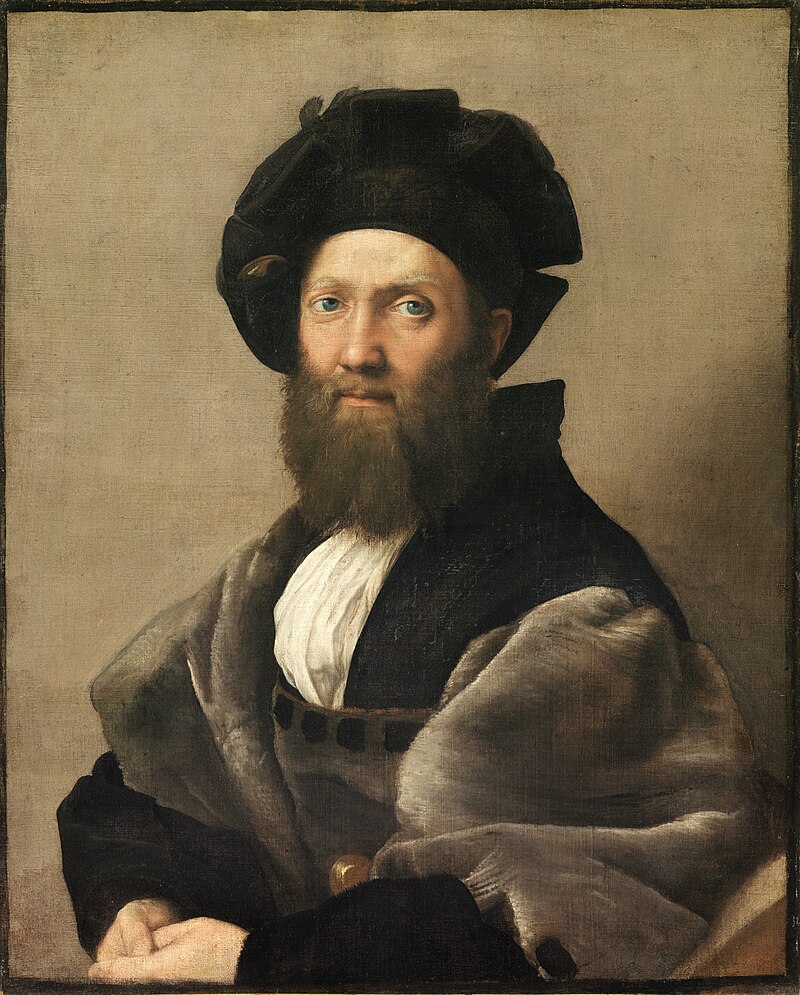
The painting “Baldassare Castiglione” by Raphael is a portrait of an Italian courtier, diplomat, and writer. The painting depicts Castiglione in a noble and refined manner, reflecting the ideal courtier during the Renaissance period.
Raphael’s use of light and shadow creates a harmonious balance in the composition and emphasizes the subject’s features. Castiglione’s pose is natural yet dignified, wearing ornate clothing that portrays his status as a member of nobility. He gazes directly at the viewer with an expression filled with intelligence and composure.
This portrait serves as an example of Renaissance ideals, focusing on humanism and individualism. Baldassare Castiglione was highly regarded as a man who embodied these values through his writings on ethics, literature, art, and politics. The painting captures both his physical appearance and inner character traits that made him so revered during this period.
30. Assumption Of The Virgin by Titian
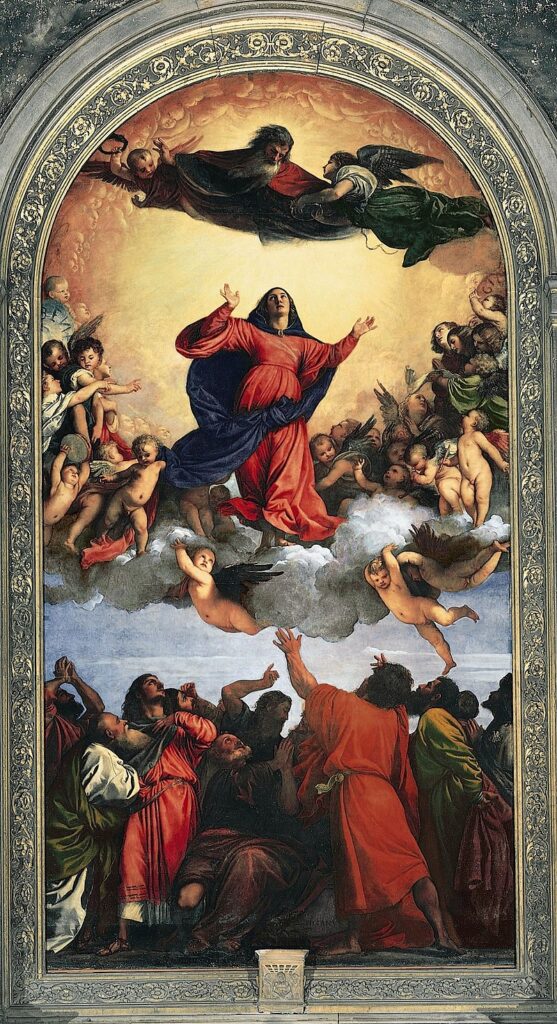
Assumption of the Virgin by Titian is a religious painting portraying Mary being lifted up to heaven by angels. The composition is dynamic and skillfully draws the viewer’s eye towards Mary at the center of the piece, emphasizing her importance. The painting is full of religious symbolism and iconography, which add to its significance.
Titian’s use of colors and light creates a dramatic effect that adds to the sense of divine transcendence in the painting. The colors used in this masterpiece are vibrant, with bright blues dominating much of the sky, conveying a celestial tone.
The Assumption of the Virgin is considered one of Titian’s most important works as it exemplifies his great artistic skills. This masterpiece reflects not only his insatiable creativity but also his ability to depict religious themes in a profound manner.
31. Madonna Della Sedia by Raphael
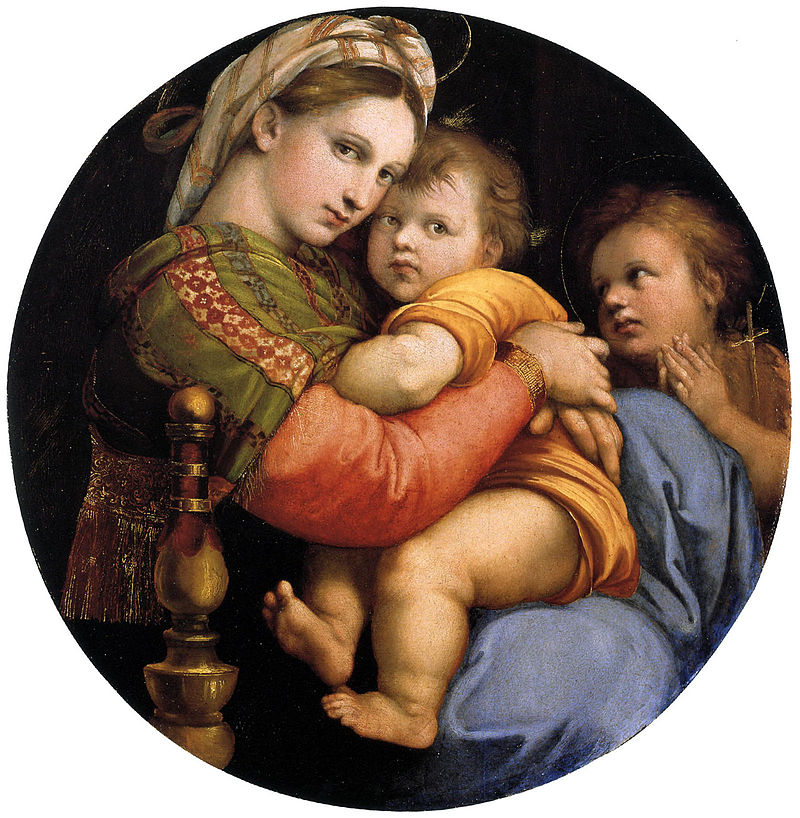
Madonna della Sedia is a masterpiece painting by Raphael, one of the most famous artists of the Italian Renaissance. The painting depicts the Virgin Mary holding her son, Jesus Christ, and a young John the Baptist who is looking up to them. It’s believed to have been painted in 1514 and is currently housed in the Palazzo Pitti museum in Florence, Italy.
The composition of Madonna della Sedia showcases some of Raphael’s greatest artistic talents. The painting has a circular format that creates an intimate setting between Mary and her son. Both figures are positioned close together, their heads are tilted towards each other and they gaze affectionately into each other’s eyes. Mary holds baby Jesus on her lap while she looks out to meet the viewer’s eyes.
One striking aspect of Madonna della Sedia painting is its use of vibrant colors. Raphael used warm tones such as yellow ochre for Mary’s robe, red for young John’s clothing and blue for Jesus’ garment to create a harmonious color scheme that highlights their individual identities.
32. The Virgin Of Chancellor Rolin by Jan Van Eyck
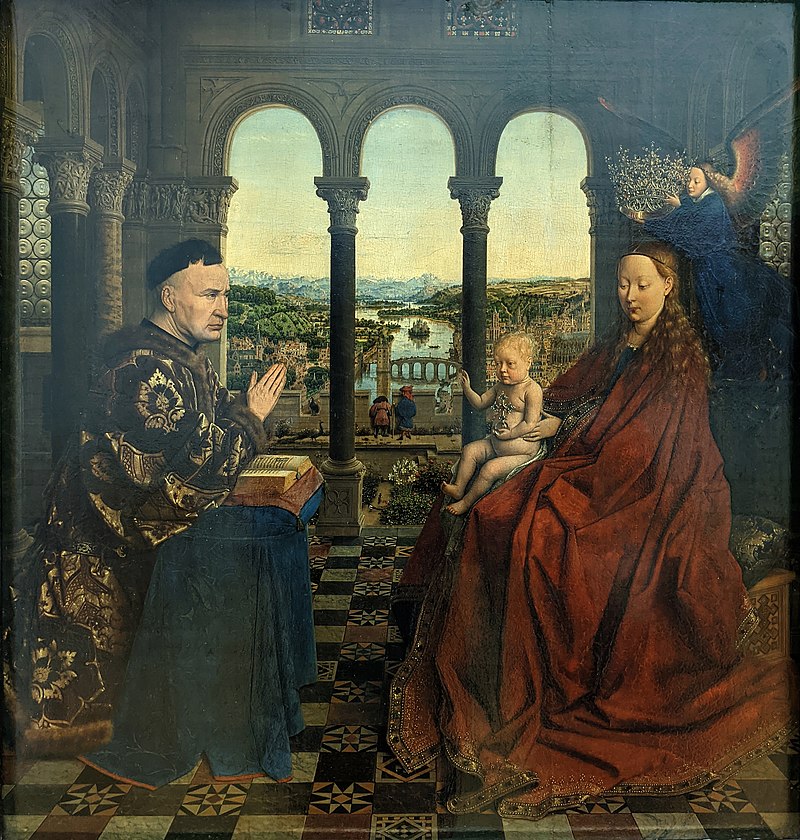
The Virgin of Chancellor Rolin is one of the masterpieces of Northern Renaissance art, painted by Jan van Eyck in 1435. The painting depicts Nicolas Rolin, a chancellor of Burgundy, kneeling before the Virgin Mary. The setting is an outdoor space with a meandering river and hills depicted in the background.
Van Eyck’s use of oil-based paint allowed him to create intricate details that make the painting stand out. Incredibly fine brush strokes were used to depict objects such as the folds on Chancellor Rolin’s robes. Looking closely at the painting, one can notice striking colors and individual elements like gold embroidery that make it seem more alive.
Today this artwork can be found on display at the Louvre museum in Paris where it is appreciated by art enthusiasts from all over the world who want to catch a glimpse of its intricate beauty and unique place in art history.
33. Sistine Chapel Ceiling by Michelangelo
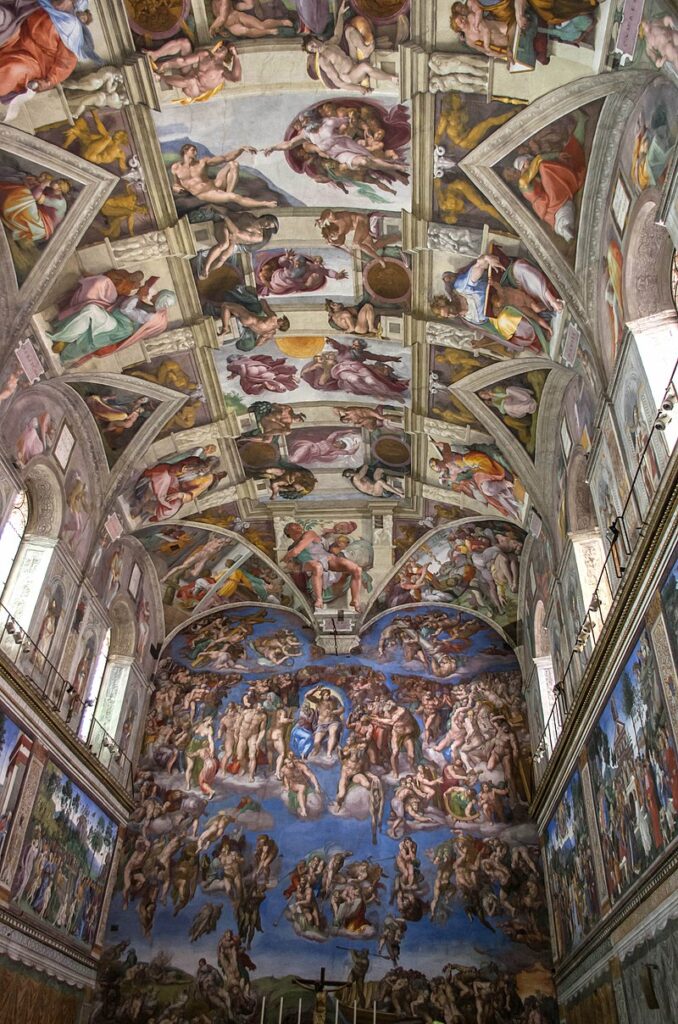
The Sistine Chapel ceiling is one of the most iconic works of art in history. Commissioned by Pope Julius II in 1508, it took Michelangelo four years to complete. The ceiling is about 40 meters long and 13 meters wide.
The fresco depicts various scenes from the Book of Genesis, starting with the creation of light and ending with the story of Noah’s ark. The central panels feature nine scenes from Genesis, including the Creation of Adam and Eve, The Temptation and Expulsion from Eden, and The Great Flood.
Michelangelo used a complicated scaffolding system to paint on his back without damaging his work. He employed a technique called “buon fresco,” which involved painting on wet plaster using pigments mixed with water. This allowed him to create vivid colors that have remained vibrant for centuries.
The Sistine Chapel ceiling has undergone several restorations over the years to maintain its brilliance. In recent years, there has been some controversy regarding whether or not to clean Michelangelo’s work more aggressively or leave it as it is for historical accuracy.
34. Adoration Of The Magi by Albrecht Dürer
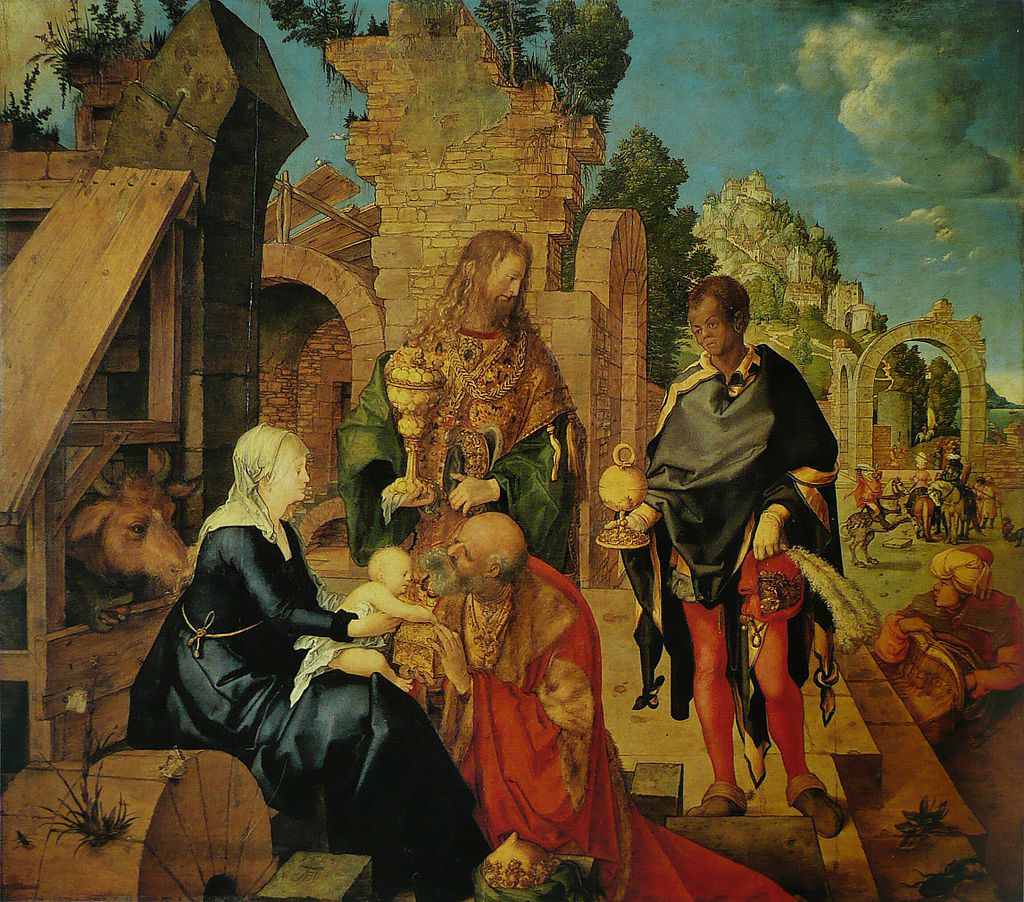
Albrecht Dürer’s painting, Adoration of the Magi, depicts the biblical scene of the Three Wise Men paying homage to Baby Jesus. Painted in 1504, it showcases Dürer’s extraordinary technical skills in creating a harmonious and intricately detailed composition.
The painting features vivid colors that highlight the rich attire of the Magi and the holy family. The horse at the center of the piece is highly detailed, taking center stage as one of Dürer’s signature elements for his paintings. The landscape background that shows ruins may allude to Christ’s reign over pagan beliefs.
The use of perspective is also remarkable in this piece as it creates an illusionistic depth to convey a sense of realism. The placement and expressions on each person’s face are very deliberate and evocative too.
35. Albrecht Dürer Self-portrait
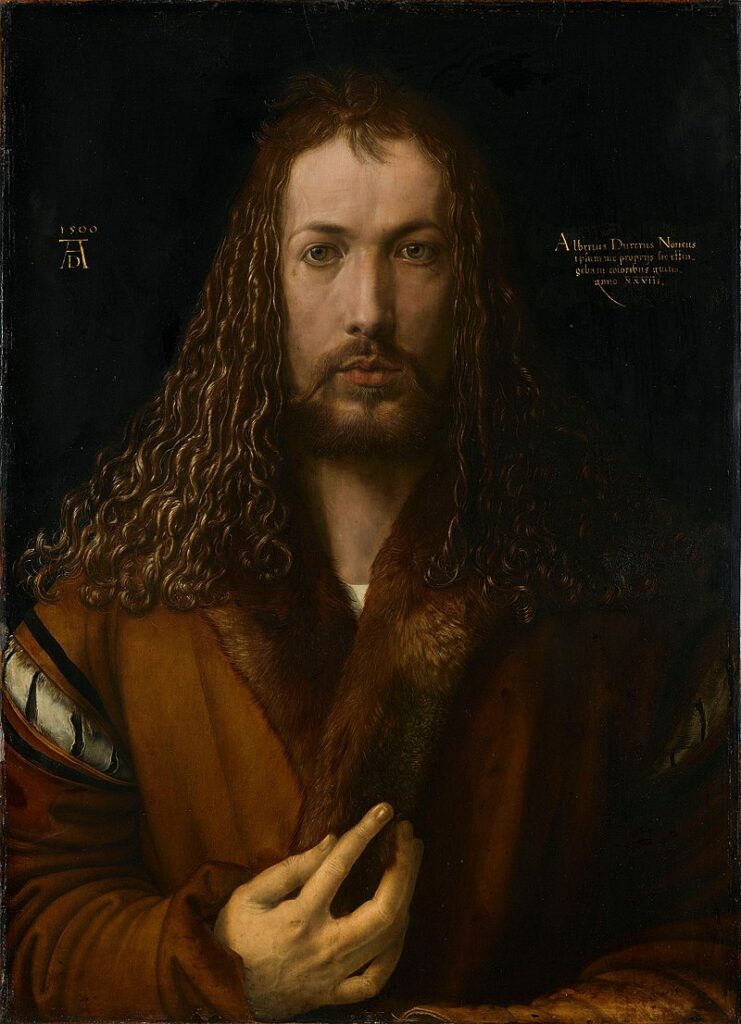
Albrecht Dürer’s self-portrait is a masterpiece in the realm of Renaissance art. Painted in 1500, it depicts the artist as a confident and youthful figure, gazing out at the viewer with an intense expression. The painting is notable for its incredible attention to detail, particularly in the intricate folds of Dürer’s clothing and his finely rendered hair.
One of the most striking aspects of this painting is its use of light and shadow. The background behind Dürer is shrouded in darkness, which serves to highlight his features even more dramatically. This creates a sense of depth and dimensionality that draws the viewer’s eye into the image.
Another interesting feature of this self-portrait is Dürer’s use of symbolism. In one hand, he holds a sprig of juniper, which was thought to have protective qualities during the time period when this painting was created. In his other hand, he holds what appears to be an inscription tablet or piece of paper with an inscription on it. These elements add layers of meaning and complexity to an already fascinating work.
36. Fisherman’s House On A Lake by Albrecht Dürer
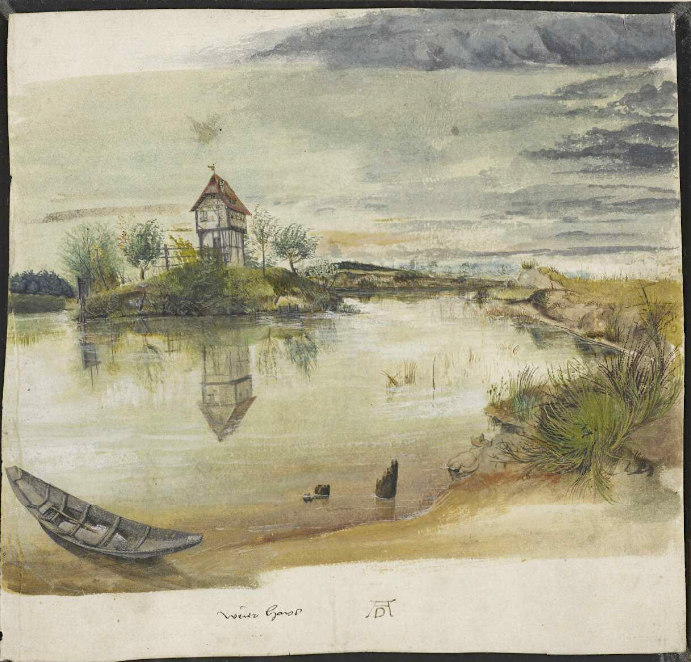
Albrecht Dürer’s “Fisherman’s House on a Lake” painting depicts a serene, peaceful scene of a small house on the edge of a lake with trees in the background. The painting shows a fisherman’s modest dwelling, which is believed to symbolize the simple life and appreciation for nature.
Dürer was known for his detailed and realistic style, which is evident in this piece. The trees in the background are intricately detailed, showcasing Dürer’s attention to detail. Additionally, the reflection of the house and trees on the calm lake adds depth to the painting.
One interesting aspect of “Fisherman’s House on a Lake” is its use of space. The small house takes up only a fraction of the canvas but creates an impactful presence. Meanwhile, much of the space is dedicated to portraying nature and its beauty.
37. Virgin And Child With St. Anne by Leonardo Da Vinci
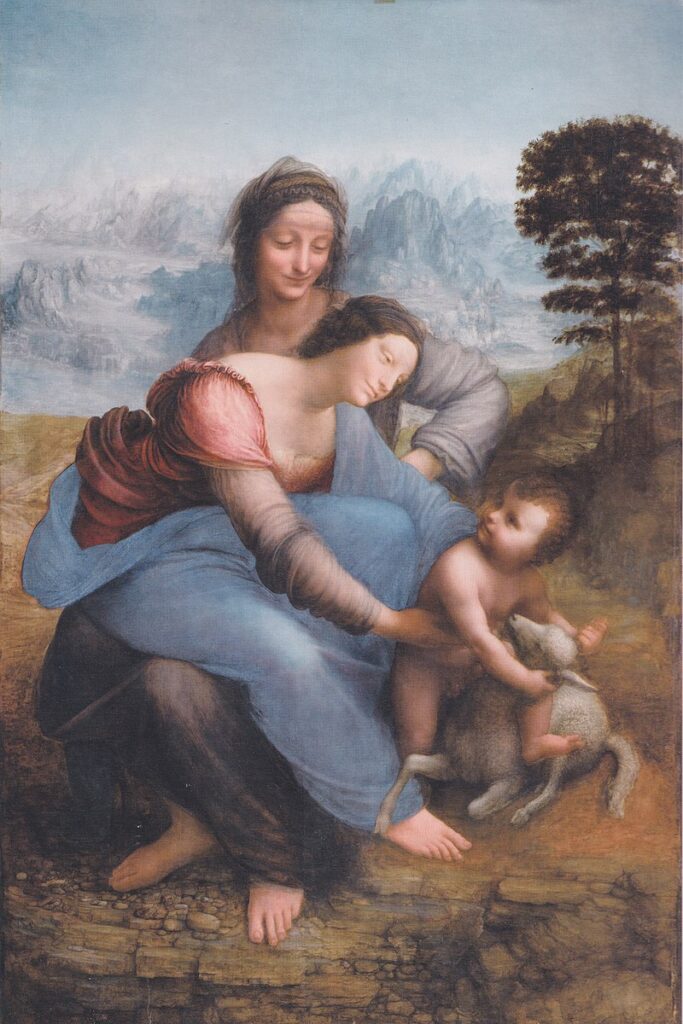
Leonardo da Vinci’s painting, “Virgin and Child with St. Anne,” is widely recognized as a masterpiece of the High Renaissance. The painting depicts three figures: the Virgin Mary, her mother St. Anne and Mary’s infant son Jesus Christ. One of the most striking aspects of the painting is the complex and intricate relationship between these figures.
In this masterpiece, Leonardo skillfully portrays an intimate moment between three generations where St. Anne lovingly holds Mary while she herself holds Jesus on her lap, creating a touching image that represents maternal love across generations. It is said that even contemporary art critics can appreciate how intricate each figure in this artwork is portrayed, down to their body language and expressions.
38. Man In A Red Turban by Jan Van Eyck
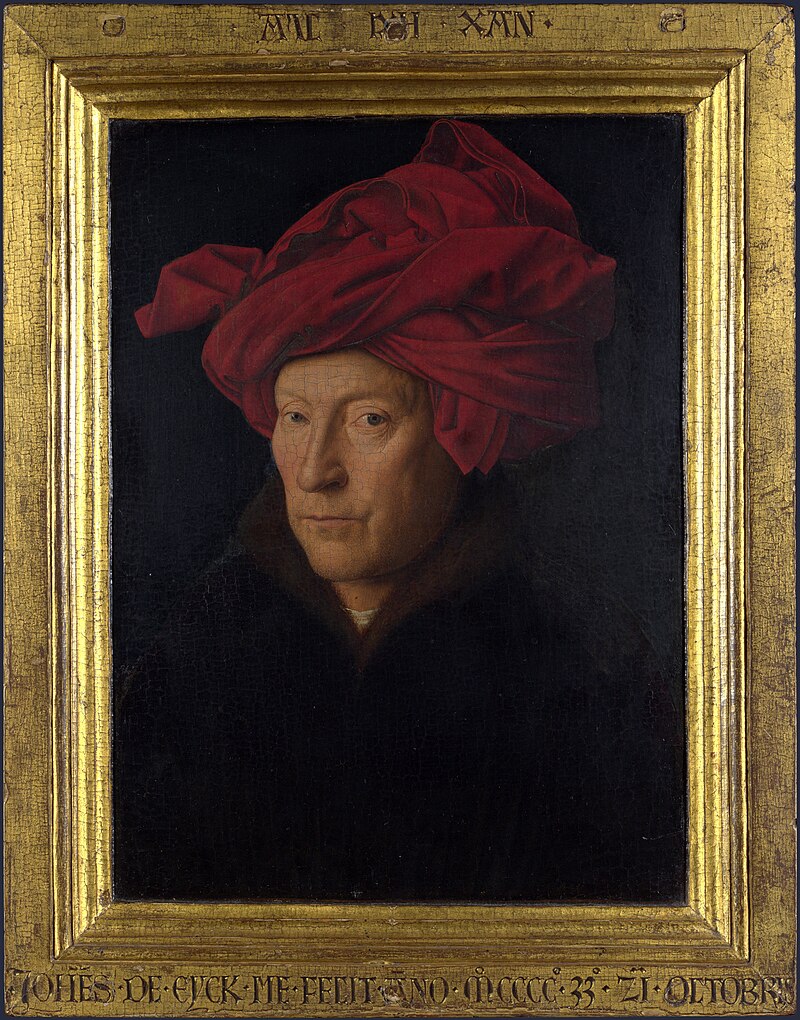
Jan van Eyck’s “Man in a Red Turban” is an oil painting that depicts a middle-aged man facing the viewer with his head turned slightly, wearing a dark robe and a red turban. The painting is thought to have been completed in 1433 and is now housed at the National Gallery in London.
One notable aspect of the painting is the level of detail. Jan van Eyck was known for his ability to accurately render textures, such as the folds of fabric or individual strands of hair. This is evident in the wrinkles on the man’s forehead, as well as in the intricate pattern on his turban.
The identity of the man depicted in the painting remains unknown, but historians speculate that he may have been a merchant or another individual from an affluent background due to his clothing and jewelry. The painting has also been interpreted as an example of secular portraiture during a time when religious themes prevailed in art.
39. Battle Between Love & Chastity by Perugino
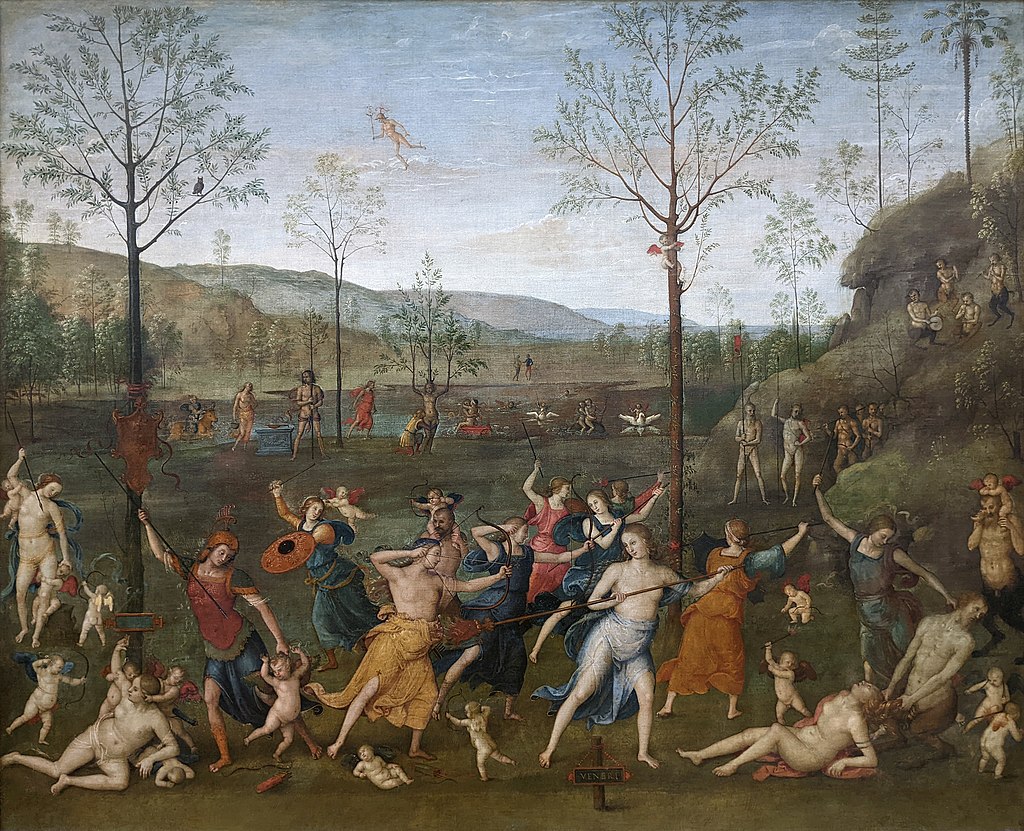
Perugino’s painting, “Battle Between Love & Chastity,” is a masterpiece that depicts a scene of two women fighting while being watched by angels. The painting symbolizes the struggle between earthly desires and spiritual purity. One woman represents love, portrayed as alluring and sensual, while the other represents chastity and depicted as pure and virtuous.
The women are shown in battle with love being dragged down by demons while chastity is helped by angels lifting her up. The contrast between the two can easily be seen in their facial expressions; Love has an expression of desperation while Chastity appears serene. The figures are colorfully painted with fine lines bringing out every detail on them.
One interesting aspect of this painting is how Perugino uses angels to symbolize purity, strength, and virtue. This technique portrays chastity as not only good but also divine. Another fascinating aspect of this artwork is how it illustrates the contrast between pleasure-seeking represented by Love versus moral rectitude represented by Chastity.
40. Dante by Domenico Di Michelino
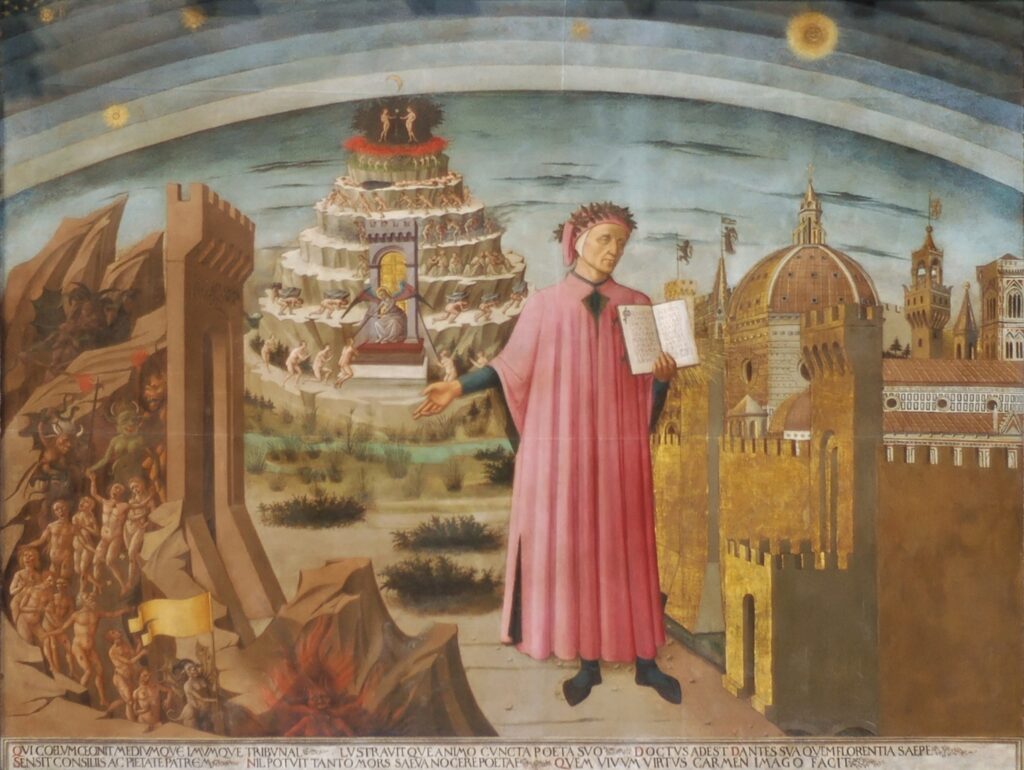
Dante by Domenico di Michelino is a renowned painting created in Florence in 1465. The artwork depicts Dante Alighieri, the great Italian poet, standing in front of the city of Florence with his famous work, The Divine Comedy, clasped in his hands. This iconic painting has become a symbol of the city’s cultural and artistic heritage.
One of the notable features of this painting is its use of allegory to depict Dante’s writing and connection with Florence. For instance, the characters from The Divine Comedy are represented as allegories for different aspects of Dante’s literary work. Additionally, the painting reflects Renaissance-era values of human emotion and individualism through its portrayal of Dante.
The prominent positioning of both Dante and Florence within this piece makes a clear statement about their significance to one another’s history. While portraying Dante as a symbol for Florentine literature and artistry, it also highlights his patriotism towards Florence.
41. Mystic Nativity by Botticelli
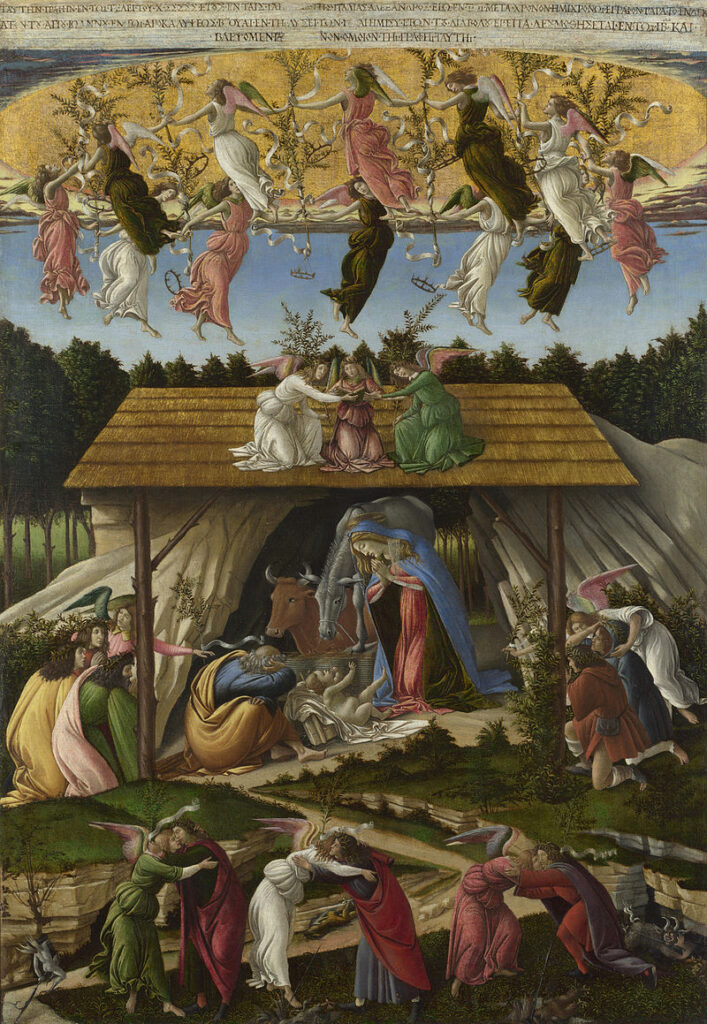
Mystic Nativity is a painting by Italian Renaissance artist Sandro Botticelli. Completed in 1500, the painting is currently housed at the National Gallery in London.
The painting depicts the birth of Jesus Christ as described in the Bible. However, what sets this piece apart from other nativity scenes is its mystical and spiritual nature. The figures are depicted with elongated bodies and stylized features, giving them an otherworldly appearance. The scene itself appears to take place in a dream-like setting, with angels, demons, and mythological creatures surrounding the holy family.
Botticelli was a member of the Florentine School of art during the early Renaissance. His style often featured religious subjects rendered with special attention given to color and line. Mystic Nativity exemplifies these qualities with its vibrant use of color and intricate detailing.
42. Adoration Of The Magi by Botticelli
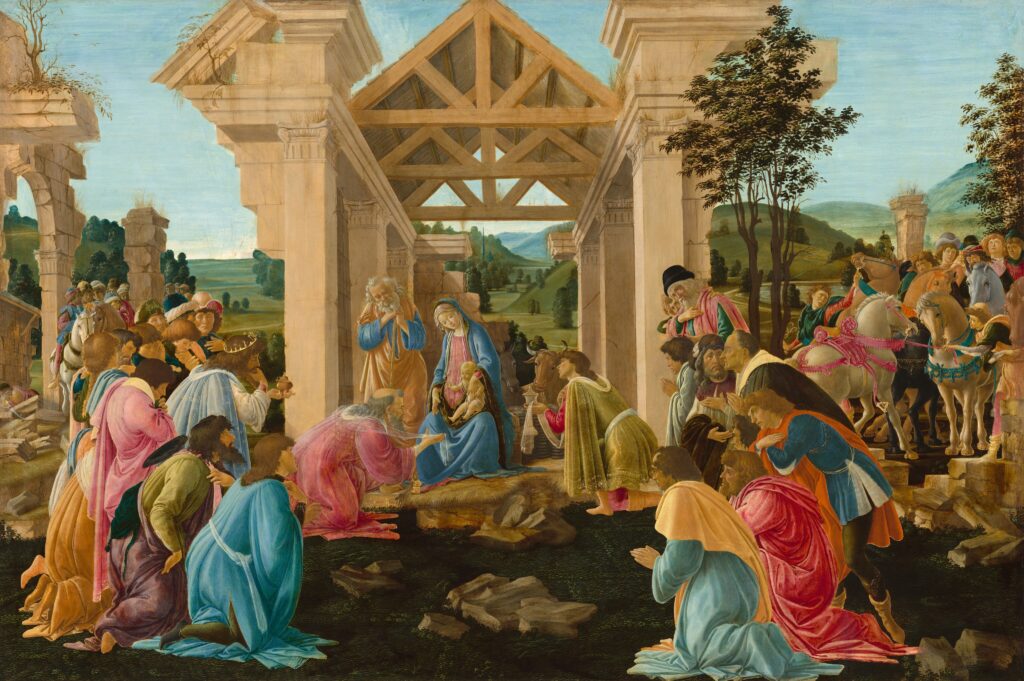
Adoration of the Magi by Botticelli is a Renaissance painting that depicts the biblical scene of the Three Wise Men visiting Jesus after his birth. The painting stands at 70 x 104.2 cm inches and was created using tempera and gold leaf on wood panel in the late 15th century.
The painting showcases a crowded scene with over thirty figures, emphasizing Botticelli’s aptitude for detail and proportion. The infant Jesus lays in Mary’s arms, with Joseph by her side. The Virgin Mary wears a deep blue robe – typical of her portrayal in art during this period.
The central figures are joined by several layers of individuals including angels observing from above, other followers bringing gifts to Christ, John the Baptist, camels with cargo and most notably – the three kings or wise men who have traveled from afar to worship baby Jesus.
One notable aspect behind this piece of art is its depth through use of shading which makes viewers feel as though they too are viewing it live from within the painting.
Interesting fact, this artwork was dedicated to Medici family members who were important literary patrons during their reign in Florence society (the place where Adoration Of Magi was created).
43. The Ghent Altarpiece by Jan Van Eyck
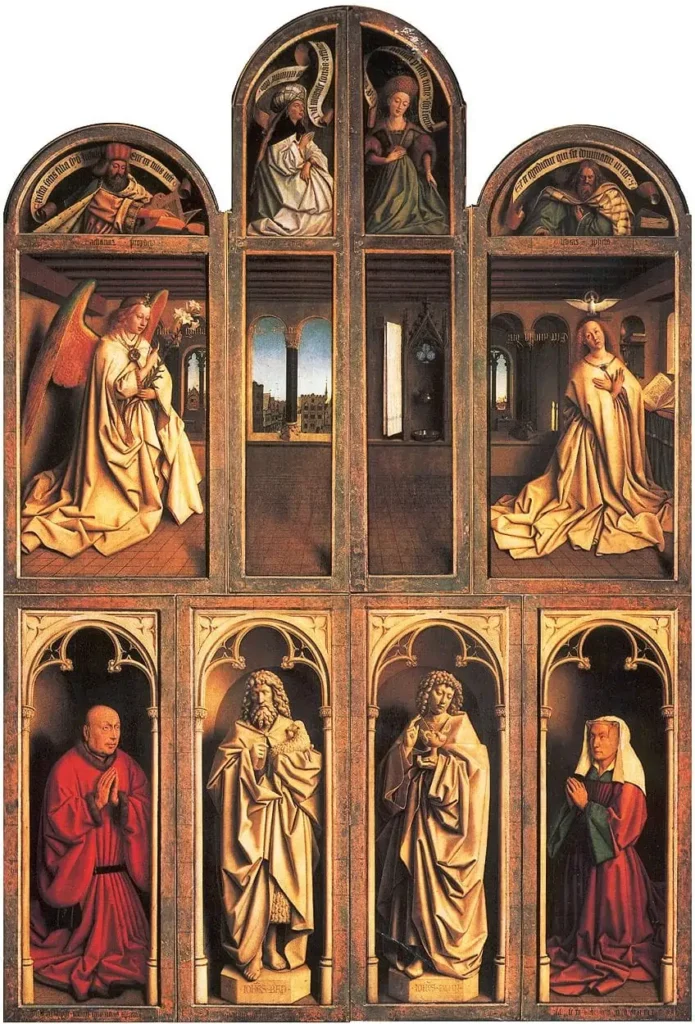
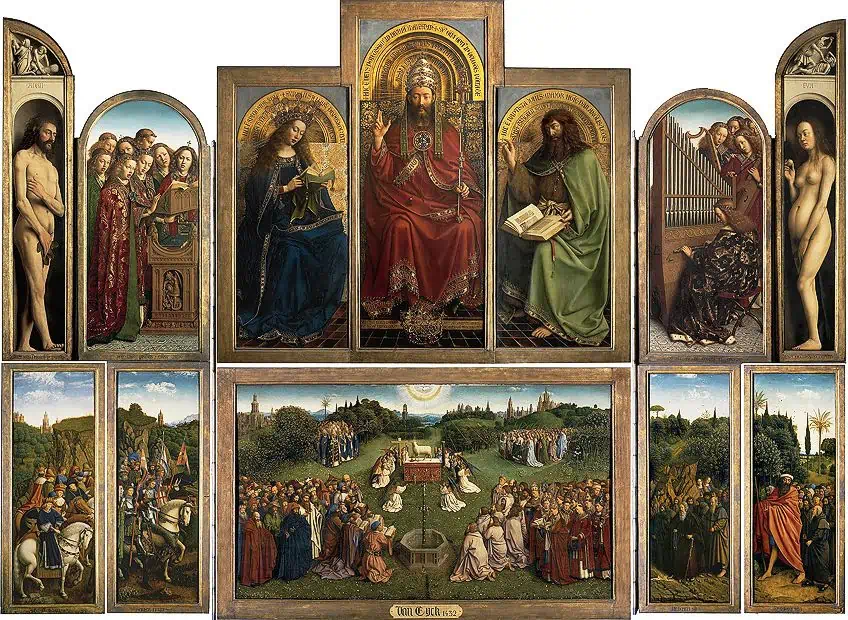
The Ghent Altarpiece by Jan van Eyck is one of the most famous and complex artworks in Western art history. It is a polyptych consisting of twelve panels that are hinged together, allowing for various configurations depending on the liturgical season.
The central panel depicts the Adoration of the Mystic Lamb, with Christ as the Lamb of God being worshiped by angels, apostles, and Mary and John the Baptist. The outer panels depict various saints and figures from the Bible, including Adam and Eve, who are shown nude in an elaborate landscape setting. The lower panels contain grisaille paintings, or monochromatic scenes that mimic sculpture.
The masterpiece’s meticulous detail attests to Van Eyck’s innovative use of oil paint which allowed him to create vivid colors and realistic textures like never before seen in painting at that time. Additionally, there are numerous hidden meanings scattered throughout the artwork such as religious symbolism-creating layers upon layers of interpretations.
44. Virtue Triumphant Over Vice by Mantegna
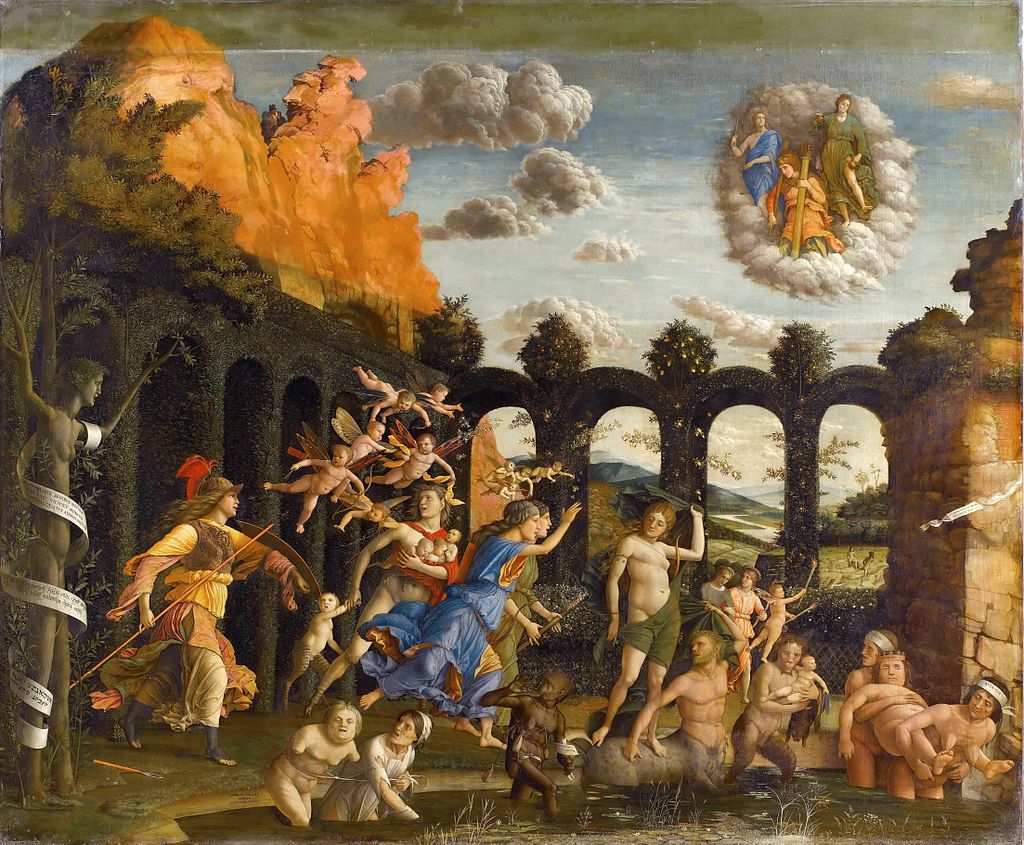
Virtue Triumphant over Vice is a painting created by Andrea Mantegna during the Italian Renaissance period. This painting depicts Virtue, represented by a beautiful nude woman holding a banner, triumphing over Vice, who is shown as an old, wrinkled woman with snakes around her arms. The background of the painting shows several men being led away from Vice’s shackles and towards Virtue.
Mantegna was known for his use of perspective in his artwork, and this piece is no exception. The scene takes place in an outdoor setting with grand columns on either side and mountains visible in the distance. The use of foreshortening creates a sense of depth and realism in the figures’ poses.
Additionally, Mantegna’s attention to detail is evident throughout the painting. From the intricate design on Virtue’s banner to the texture of Vice’s clothing, every element has been carefully crafted to create a stunning work of art.
45. The Agony In The Garden by Mantegna
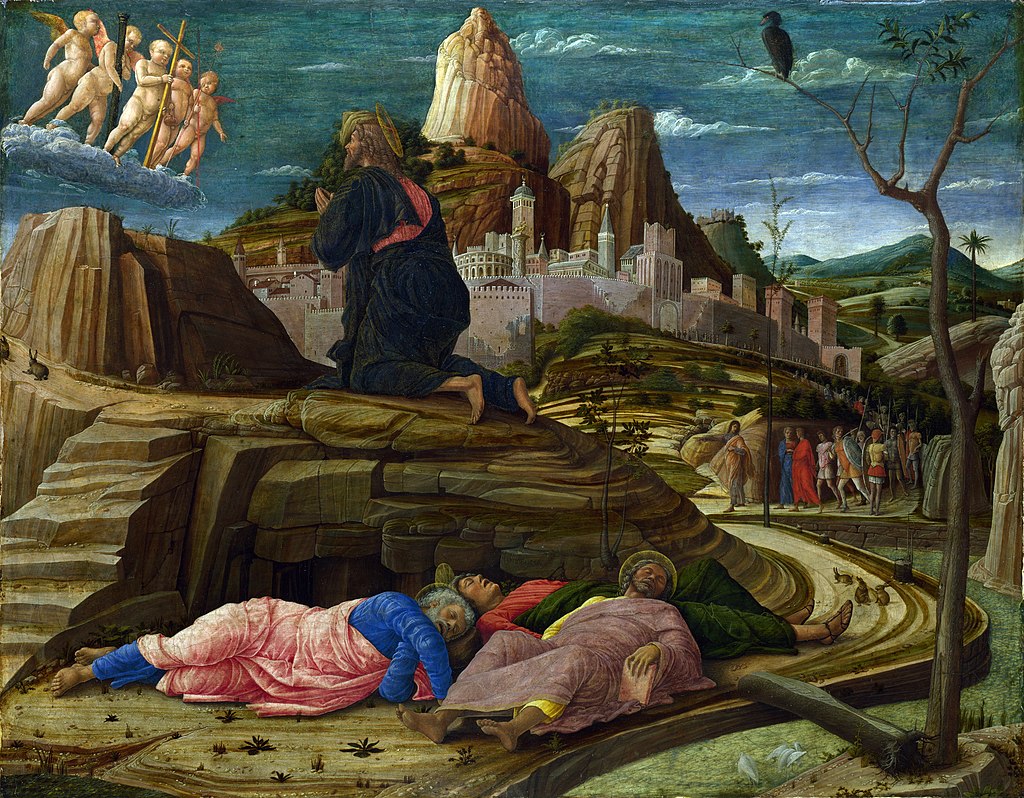
The Agony in the Garden is a painting by Andrea Mantegna. It depicts the moment when Jesus, praying in the Garden of Gethsemane, foresees his imminent betrayal and crucifixion. The painting captures the intense emotions felt by Jesus as he struggles with his impending fate.
Mantegna’s use of color and shadow adds depth to the painting and creates a sense of drama. The dark background intensifies the focus on Jesus’ facial expression, conveying his anguish and pain. The figures in the foreground are depicted in a realistic manner, adding to the emotional impact of the scene.
This masterpiece also showcases Mantegna’s technical skills as an artist. His attention to detail is evident throughout the work, particularly in the intricate folds of fabric on Jesus’ robe and coarseness of Peter’s attire. Symmetry is present between Jesus Christ’s raised left hand towards heaven that gives hope while at his right, holding an olive branch symbolizes peace.
46. Doge Leonardo Loredan by Giovanni Bellini
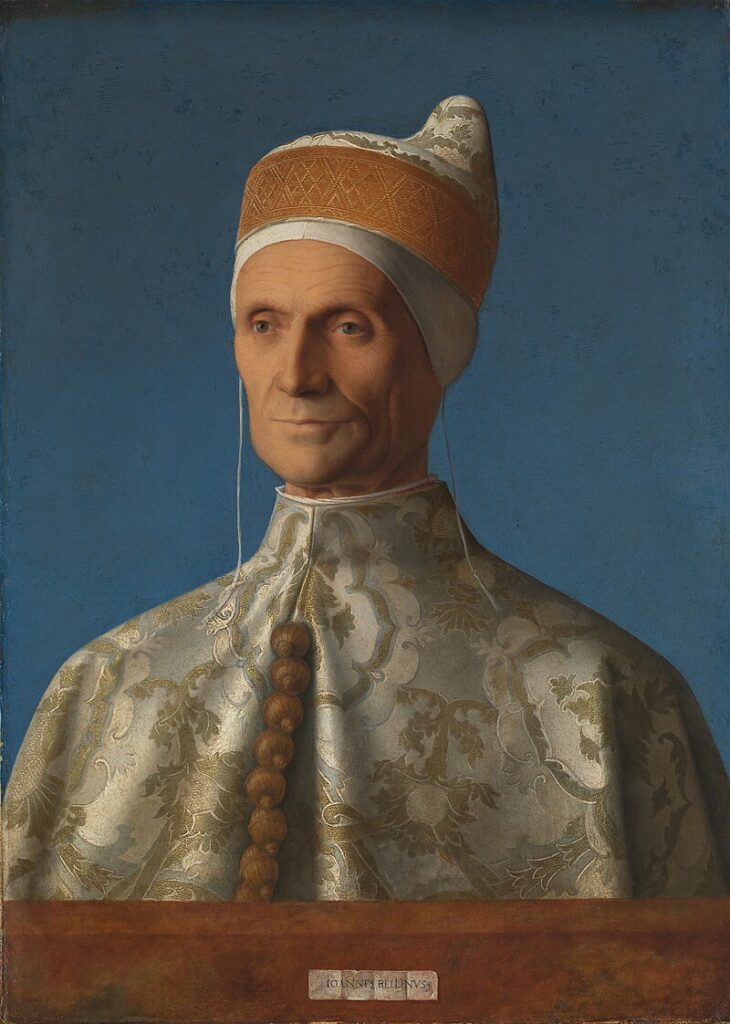
In the painting “Doge Leonardo Loredan” by Giovanni Bellini, we see a vivid depiction of the political and cultural climate of 16th-century Venice. The painting features Doge Loredan, a powerful figure in Venetian politics, seated in full regalia on his throne. Behind him is a beautifully rendered landscape that includes the city’s famous buildings and gondolas.
Bellini depicts Loredan with great attention to detail, capturing the rich textures and colors of his clothing and jewelry. The doge’s calm expression and dignified posture convey his authority and power. This portrait was likely commissioned as an official representation of the doge, designed to reinforce his image as a strong leader.
Beyond its political significance, “Doge Leonardo Loredan” is also regarded as a masterpiece of Renaissance art. Bellini’s skillful use of light creates depth and texture in the painting, while his attention to detail is evident in every brushstroke. Viewing this work offers us insight into both Venetian history and artistic techniques from that era.
47. Lady At Her Toilet by Giovanni Bellini
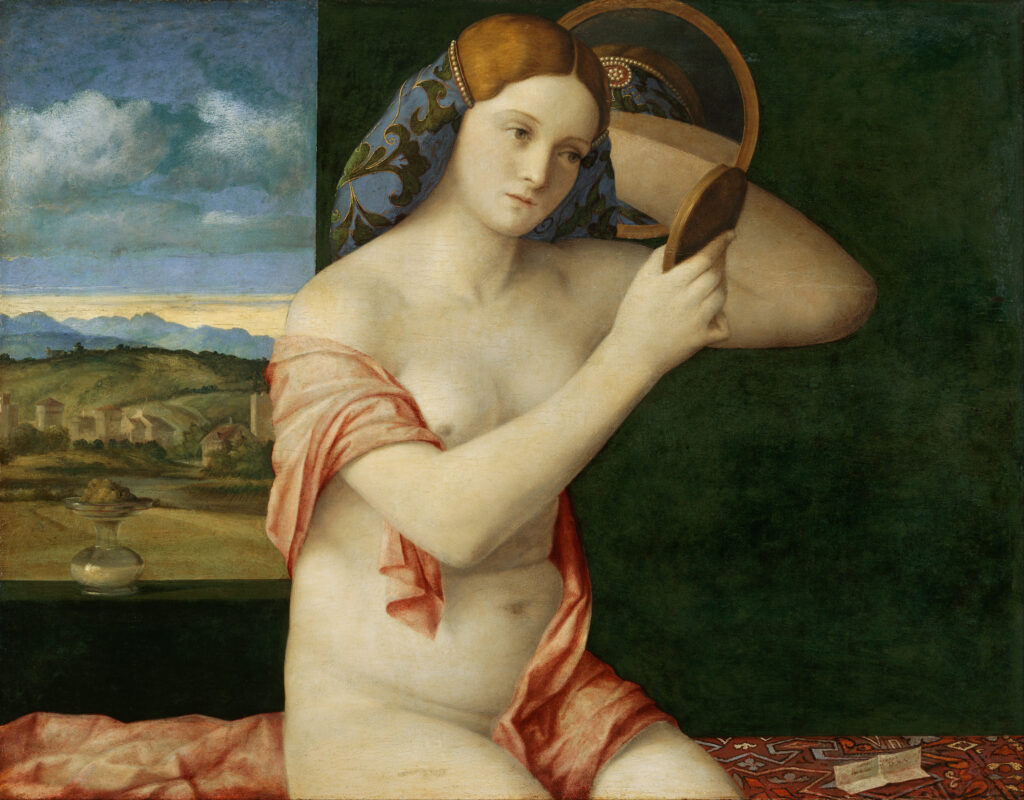
Giovanni Bellini was an Italian Renaissance artist known for his outstanding paintings, including the famous “Lady at Her Toilet.” The painting depicts a woman in her private chamber, attended by her handmaidens as she prepares to dress. It is believed to have been painted in the late 15th century and is currently exhibited at Palazzo Pitti in Florence.
The painting’s style reflects the exquisiteness of the Renaissance period, with Bellini masterfully crafting each element of the scene. The color palette consists mainly of rich reds, blues, and greens that blend beautifully together, while the use of light and shadow creates depth and realism. Details such as the delicate fabrics of the dresses and veil add to the overall elegance of “Lady at Her Toilet.”
One interesting aspect of this painting is its subject matter. Rarely during this period did artists depict women attending to their personal needs or everyday activities. This may be why “Lady at Her Toilet” stands out among other works from its time.
48. Ecstasy Of Saint Francis by Giovanni Bellini
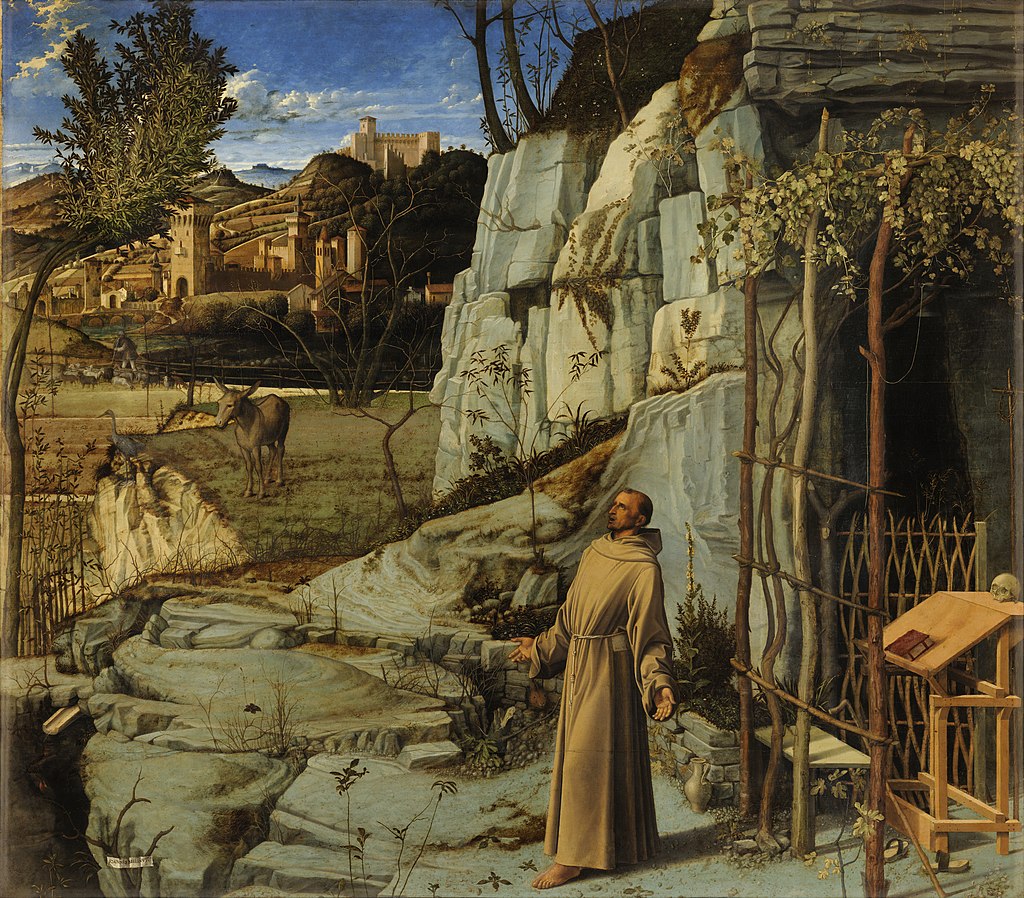
Giovanni Bellini’s Ecstasy of Saint Francis is a painting that depicts St. Francis of Assisi receiving the stigmata, or the wounds of Christ, which was believed to have occurred after his deep contemplation and prayer. This oil on canvas painting, created in the late 1470s, is now housed at the Frick Collection in New York.
The painting showcases Bellini’s mastery of color and light. The vivid colors used throughout the painting are typical of Venetian art in that period, with warm hues dominating and bright tones accentuating specific details such as St. Francis’ facial expression and gaze towards heaven. The use of light coming from an unknown source (likely symbolic) lends a mystical quality to Saint Francis’ experience.
Bellini is known for his ability to create detailed and crisp textures within his paintings. This can be seen through Saint Francis’ robe that appears almost tactile – one would want to reach out and touch it – as well as the carefully painted rocks behind him which display a naturalistic rendering with lifelike shadows.
